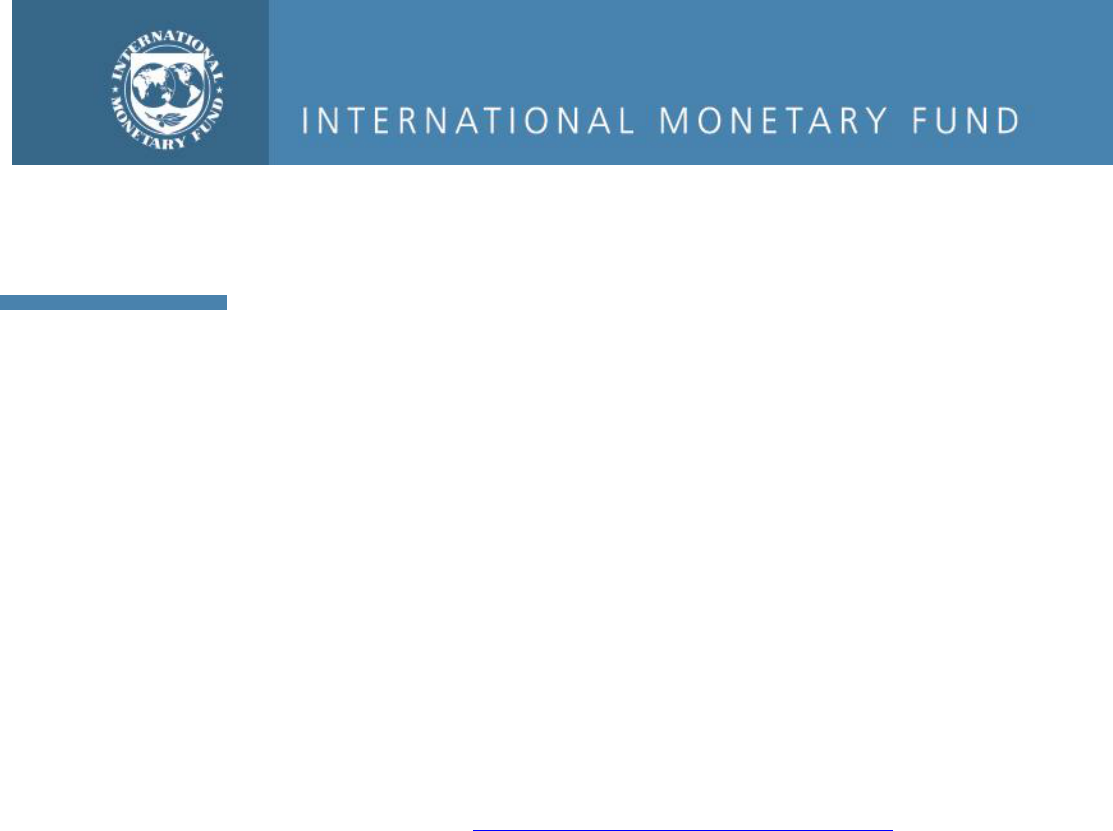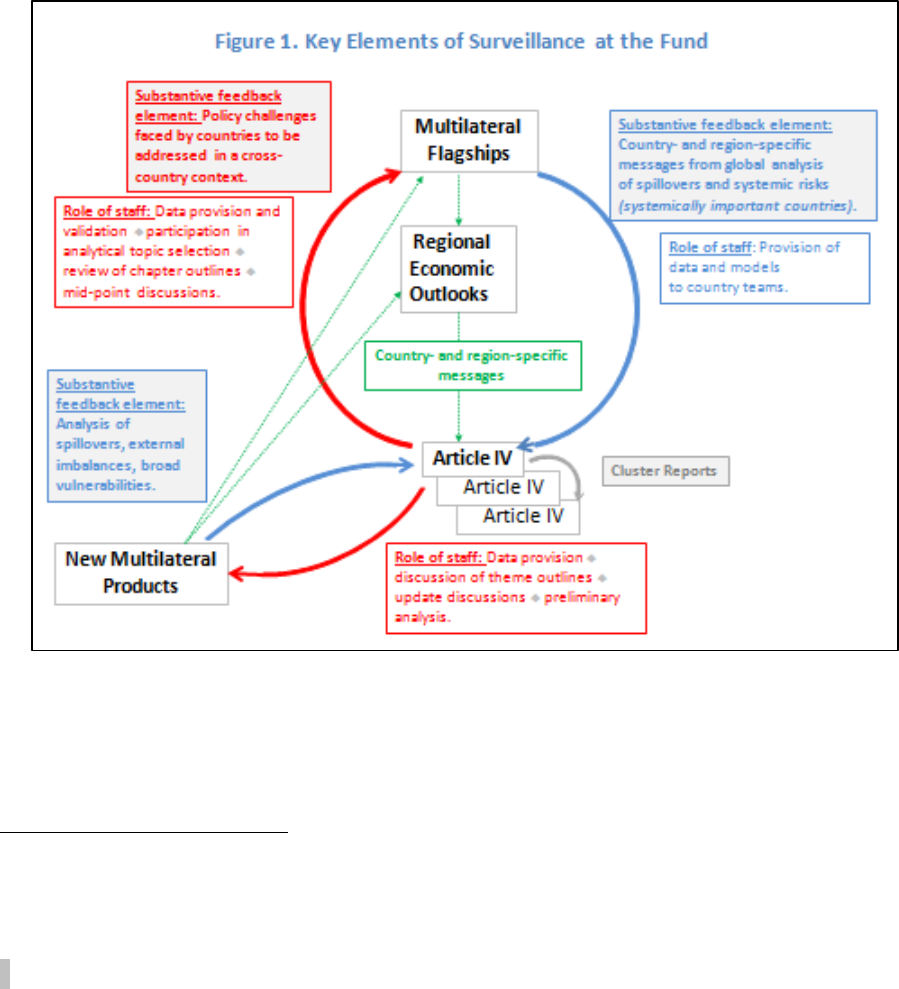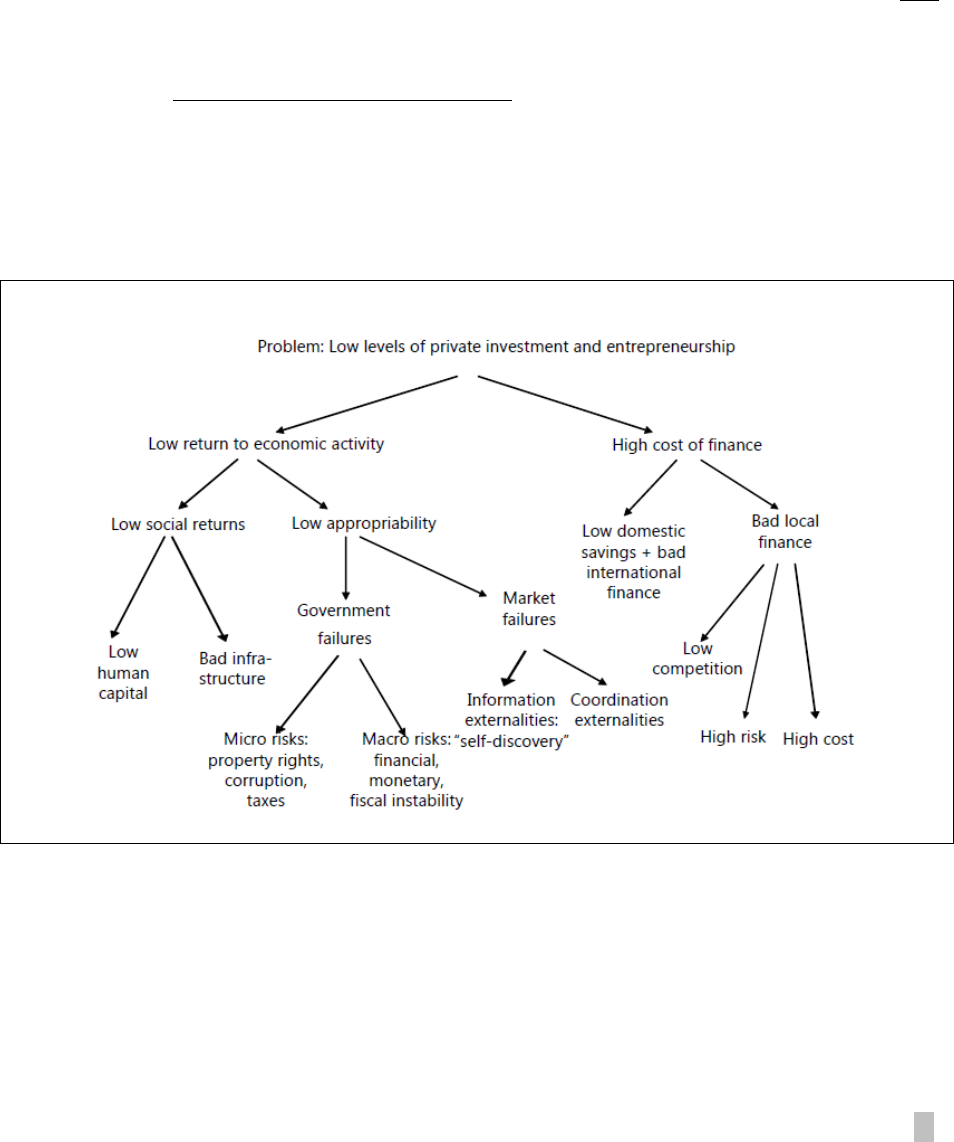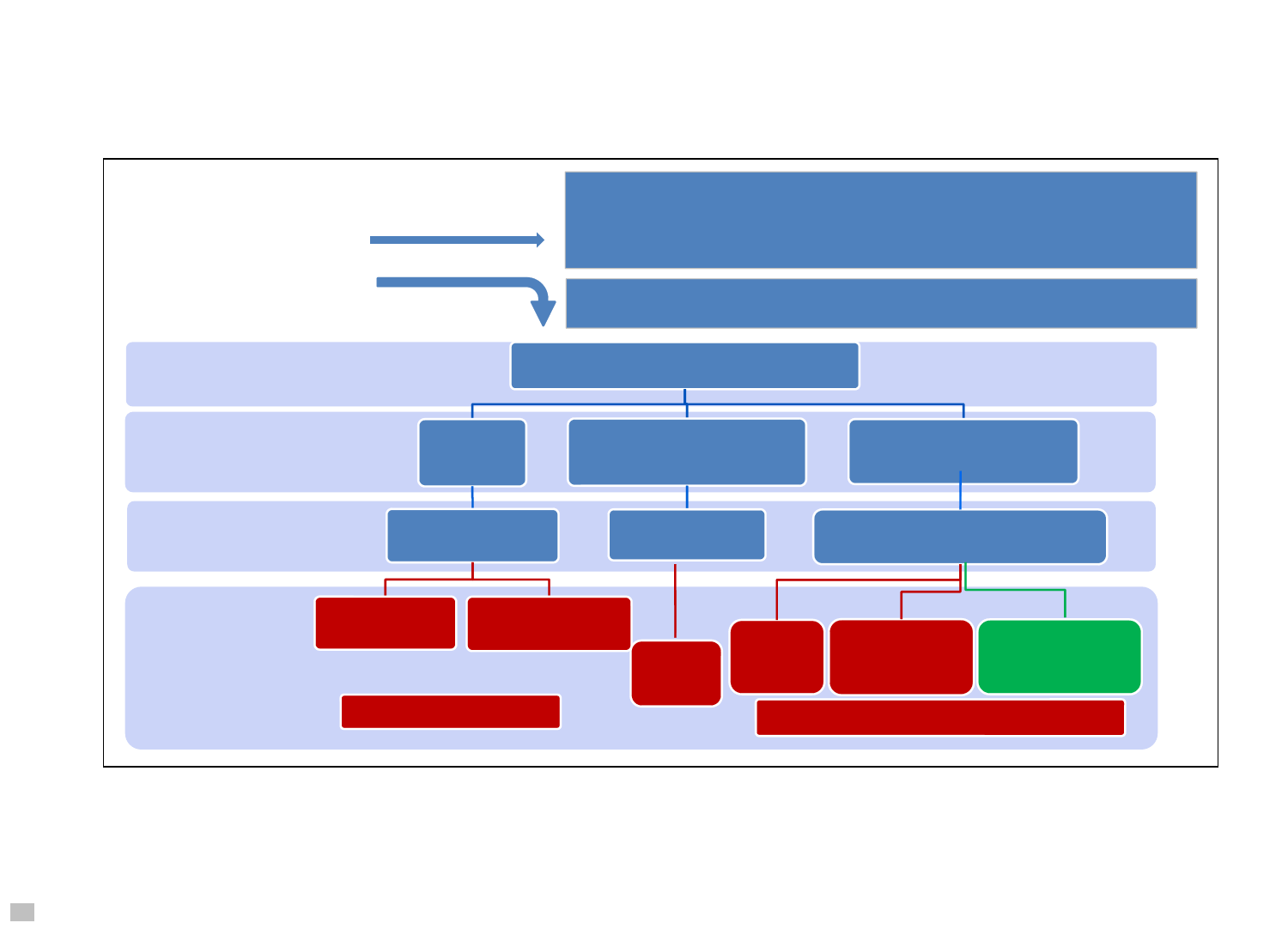
© International Monetary Fund
Guidance Note for Surveillance under Article IV
Consultation
IMF staff regularly produces papers proposing new IMF policies, exploring options for reform,
or reviewing existing IMF policies and operations. The following document has been released
and is included in this package:
The Staff Report on Guidance Note for Surveillance under Article IV Consultation
prepared by IMF staff and completed on March 19, 2015.
The staff report was issued to the Executive Board for information.
The policy of publication of staff reports and other documents allows for the deletion of
market-sensitive information.
Electronic copies of IMF Policy Papers
are available to the public from
http://www.imf.org/external/pp/ppindex.aspx
International Monetary Fund
Washington, D.C.
May 2015

GUIDANCE NOTE FOR SURVEILLANCE UNDER ARTICLE IV
CONSULTATIONS
EXECUTIVE SUMMARY
This note provides country teams with guidance on bilateral and multilateral
surveillance in the context of Article IV consultations. It covers the following issues:
Focus on stability. Stability is the organizing principle of surveillance. Article IV
consultations should focus on the conduct of economic and financial policies
pursued by members to promote present and prospective domestic and balance
of payments stability, as well as global economic and financial stability. For the
latter, Article IV consultations should discuss spillovers from members’ economic
and financial policies that may significantly affect global stability, including
alternative policy options that would minimize their adverse impact.
Operational guidance. The note provides detailed guidance, suggestions and
references in areas covered in surveillance including risks and spillovers, fiscal
policy, macrofinancial and monetary policy, BOP stability, structural policies and
data issues.
Communication and Engagement. Effective two-way communication is key to
surveillance, including with the authorities (to help staff’s advice get traction), the
Executive Board (to support effective peer review), and the public and other
stakeholders (to gain support for necessary policy adjustments). Surveillance
messages need to be clear, concise, and focused. The Fund needs to be
evenhanded, in line with the principle of uniformity of treatment, for surveillance
to command the confidence of the membership.
Process and formal requirements. A number of procedures, rules, and
requirements are summarized in this note.
This Guidance Note is not intended to provide a checklist for issues to be covered
in Staff Reports. While economic and financial stability is the overarching objective,
selectivity in Staff Reports remains critical. Staff needs to exercise judgment in how to
apply the guidelines for each specific member, and there is scope for staff to innovate and
push the analytical content beyond current practices.
March 19, 2015

GUIDANCE NOTE FOR SURVEILLANCE UNDER ARTICLE IV CONSULTATIONS
2 INTERNATIONAL MONETARY FUND
Approved By
Siddharth Tiwari
Prepared by an SPR team led by Gavin Gray comprising Zsofia Arvai,
R. Sean Craig, Mame Astou Diouf, Lawrence Dwight, and
Michael Perks, under the guidance of Taline Koranchelian.
CONTENTS
LIST OF ACRONYMS _____________________________________________________________________________ 3
I. INTRODUCTION _______________________________________________________________________________ 5
II. SCOPE OF SURVEILLANCE ____________________________________________________________________ 8
III. OPERATIONAL GUIDANCE—KEY ISSUES __________________________________________________ 12
A. Risks and Spillovers ___________________________________________________________________________ 12
B. Fiscal Policy ___________________________________________________________________________________ 17
C. MacroFinancial Analysis and Monetary Policy _________________________________________________ 21
D. Balance of Payments Stability _________________________________________________________________ 28
E. Structural Policies _____________________________________________________________________________ 36
F. Data Adequacy for Surveillance _______________________________________________________________ 41
IV. COMMUNICATION AND ENGAGEMENT___________________________________________________ 41
V. SURVEILLANCE PROCESS AND REQUIREMENTS ___________________________________________ 44
BOXES
1. Best Practices in Surveillance ___________________________________________________________________ 7
2. 2014 Triennial Surveillance Review: Operational Priorities ______________________________________ 8
3. Surveillance in Small Developing States _______________________________________________________ 11
4. Risks and Spillovers: Key Concepts ____________________________________________________________ 13
5. The Risk Assessment Matrix ___________________________________________________________________ 14
6. Techniques for Risk and Spillover Analysis ____________________________________________________ 16
7. Guidance on the ESR, EBA, and EBA-Lite ______________________________________________________ 32
8. Key Questions on Specific Jobs and Growth Challenges ______________________________________ 40
9. Drafting Guidelines ___________________________________________________________________________ 42
10. Publication and Transparency Guidelines ____________________________________________________ 43
FIGURES
1. Key Elements of Surveillance at the Fund ______________________________________________________ 6
2. Conceptual Framework for Balance of Payments Stability Analysis ____________________________ 29
3. Criteria for Coverage of Structural Issues in Surveillance ______________________________________ 36
4. Growth Diagnosis Decision Tree ______________________________________________________________ 37
5. Article IV Cycles _______________________________________________________________________________ 47
ANNEXES
I. Legal Framework and Principles _______________________________________________________________ 48
II. Consultations with Members of Currency Unions _____________________________________________ 52
III. Formal Requirements in Article IV Staff Reports ______________________________________________ 54

GUIDANCE NOTE FOR SURVEILLANCE UNDER ARTICLE IV CONSULTATIONS
INTERNATIONAL MONETARY FUND 3
LIST OF ACRONYMS
AML Anti-Money Laundering
AREAER Annual Report on Exchange Arrangements and Exchange Restrictions
BSA Balance Sheet Analysis
CA Current Account
CFM Capital Flow Management Measure
CFT Combating the Financing of Terrorism
COM Communications Department
CSO Civil Society Organization
DSA Debt Sustainability Analysis
DSGE Dynamic Stochastic General Equilibrium
EBA External Balance Assessment
EPA Ex-Post Assessment
EPE Ex-Post Evaluations of Exceptional Access Arrangements
ER Exchange Rate
ESR External Sector Report
FAD Fiscal Affairs Department
FCL Flexible Credit Line
FSAP Financial Sector Assessment Program
FTN FSAP Technical Note
GFSR Global Financial Stability Report
GNI Gross National Income
G20 The Group of Twenty
G-RAM Global Risk Assessment Matrix
GVAR Global Vector Auto Regression
ICD Institute for Capacity Development
ILO International Labour Organization
ISD Integrated Surveillance Decision
LEG Legal Department
LICs Low-Income Countries
LOE Languages Other than English
LOT Lapse of Time
MAC Market Access Country
MIC Middle-Income Country
MCM Monetary and Capital Markets Department
NPL Non-Performing Loan
OECD Organization for Economic Co-operation and Development
OFC Offshore Financial Center
PFM Public Financial Management
PLL Precautionary and Liquidity Line
PPP Public-Private Partnership
PSI Policy Support Instrument

GUIDANCE NOTE FOR SURVEILLANCE UNDER ARTICLE IV CONSULTATIONS
4 INTERNATIONAL MONETARY FUND
PRGT Poverty Reduction and Growth Trust
RAM Risk Assessment Matrix
REER Real Effective Exchange Rate
RES Research Department
RFI Rapid Financing Instrument
RCF Rapid Credit Facility
ROSC Report on the Observance of Standards and Codes
SEC Secretary’s Department
SEI Selected Economic Indicators
SDDS Special Data Dissemination Standard
SDS Small Developing States
SIP Selected Issues Paper
SPR Strategy, Policy and Review Department
STA Statistics Department
TA Technical Assistance
TSR Triennial Surveillance Review
UFR Use of Fund Resources
UMP Unconventional Monetary Policy
WEO World Economic Outlook

GUIDANCE NOTE FOR SURVEILLANCE UNDER ARTICLE IV CONSULTATIONS
INTERNATIONAL MONETARY FUND 5
I. INTRODUCTION
1. This note provides guidance to staff on the conduct of surveillance in the context of
Article IV consultations.
1
Surveillance involves the continuous monitoring of members’ economic
and financial policies and the global economy.
2
In Article IV consultations, staff holds pointed
discussions with country authorities on the economic situation, the authorities‘ policies
3
and how
these affect the country‘s stability—as well as global stability through spillovers where relevant—and
desirable policy adjustments. These discussions are reported to the Fund‘s Executive Board for its
consideration. The goal, through thorough analysis, candid discussions, and peer review, is to
promote the stability of individual members’ economies and global economic and financial stability,
which is a necessary condition for the effective operation of the international monetary system.
2. Close engagement and effective communication are critical for the Fund to achieve
traction in its surveillance. High quality advice is necessary but not sufficient to gain traction.
4
Engagement and consultations with the authorities go beyond producing the Article IV consultation
report, which is only one of the outputs of surveillance. The Fund’s ability to gain traction with its
policy advice also depends on the confidence and trust its advice inspires, which is influenced by the
perceived evenhandedness of surveillance.
3. Article IV reports should be selective and focus on the issues and themes that are
relevant for stability with clear advice on an appropriate mix of policies.
5
While this Guidance
Note presents issues in a comprehensive manner, staff is not expected to cover all the issues raised
here as if it were a checklist (except where specifically noted in Section V). Rather, selectivity is
critical, bearing in mind the focus on individual members’ stability as well as the effective operation
of the international monetary system—in particular through maintaining global economic and
financial stability. A thematic approach, focusing on economic challenges or goals rather than
individual sectors, can facilitate the analysis and presentation of intersectoral connections and policy
1
This note replaces the Guidance Note for Surveillance under Article IV Consultations of October 10, 2012. It reflects
the priorities agreed as part of the 2014 Triennial Surveillance Review (TSR). The terms Article IV consultation and
Article IV are used interchangeably in the remainder of this document.
2
Article IV of the Articles of Agreements requires the Fund to (i) assess members’ compliance with their obligations
under Article IV, Section 1 and, in particular, to exercise firm surveillance over the conduct of their exchange rate
policies (bilateral surveillance), and (ii) oversee the operation of the international monetary system to ensure its
effective operation (multilateral surveillance). As a means of enabling the Fund to discharge its surveillance
responsibilities, Article IV imposes on members procedural obligations to consult when requested by the Fund.
Annex I provides further guidance on the legal framework for surveillance.
3
The discussion of the baseline focuses on established policies: those policies that are in place as well as policies
announced that are, in the best judgment of the team, likely to be implemented.
4
See The Role of the IMF as Trusted Advisor (2013).
5
The concept of the mix of policies is intended to be broader than the more conventional fiscal-monetary policy mix.
Rather the “mix of policies” covers the wider range of policy levers appropriate to a member’s circumstances, which
could include financial, structural and exchange rate policies in addition to fiscal and monetary policies.

GUIDANCE NOTE FOR SURVEILLANCE UNDER ARTICLE IV CONSULTATIONS
6 INTERNATIONAL MONETARY FUND
interactions. It would also enhance discussion of and advice on the broader mix of policies, which is
essential in Article IV staff reports.
4. Effective surveillance requires candid, forward-looking analysis that leverages
multilateral surveillance. Staff reports and discussions should take a forward-looking view,
including a discussion of current and medium-term objectives and policies, as well as possible policy
responses to the most relevant contingencies.
6
Realistic projections based on established policies
are a critical input to this. Integrating the key results and messages from multilateral surveillance will
help ensure that staff adequately takes into account global trends and risks in its near- and
medium-term views (See Figure 1). Staff advice is more effective when it is specific and takes into
account the member’s specific circumstances and implementation capacity. (See Box 1: best
practices in surveillance).
6
As is long-standing practice, alternative policy scenarios with a quantified framework can also help illustrate the
impact of reforms.

GUIDANCE NOTE FOR SURVEILLANCE UNDER ARTICLE IV CONSULTATIONS
INTERNATIONAL MONETARY FUND 7
Box 1. Best Practices in Surveillance
The following qualities should permeate all aspects of surveillance work:
Collaboration. Surveillance is based on dialogue with country authorities and other stakeholders, and
persuasion. While this dialogue should be continuous, it is particularly important to seek country
authorities‘ opinion on issues of interest to them before an Article IV consultation. Staff can also draw on
the expertise of other international institutions.
Candor. Effective dialogue requires candor, both in discussions with country authorities and in staff
reports, including about risks.
Evenhandedness. Surveillance should be evenhanded (see Section Communication and Engagement),
whether economies are large or small, advanced or developing, and pay due regard to country
circumstances.
Practicality. Staff advice should be specific and take into account country specific circumstances and
implementation capacity.
Forward-looking. Staff reports and discussions should be based on realistic projections and discuss
current and medium-term objectives and policies and possible policy responses to the most relevant
contingencies.
Multilateral perspective. Where relevant, Article IV consultations should discuss potential or actual
spillovers as required by the Integrated Surveillance Decision (ISD) and can draw from experiences in
other countries.
Selectivity. While this Guidance Note presents the issues in a comprehensive manner, staff should not
view it as a prescriptive list. Reports should be focused and selective, except for certain issues that must
routinely be covered (as identified in Annex III). Rather, country teams should exercise judgment in
selecting issues for in depth coverage, and take a risk-based approach, leveraging the expertise of
functional departments and other institutions.
Timeliness. To ensure that Article IV staff reports are up-to-date when discussed at the Board and
published, staff should minimize the time between the end of discussions with authorities and the Board
meeting.
5. This note takes into account the recommendations of the 2014 Triennial Surveillance
Review (TSR) (see Box 2) and is structured as follows: Section II describes the scope of
surveillance, including key elements of the ISD. Section III provides operational guidance for key
analytical and policy areas that arise in surveillance: (i) risks and spillovers; (ii) fiscal policy;
(iii) macrofinancial analysis and monetary policy; (iv) balance of payments stability; (v) structural
policies, and discusses surveillance in low-income countries and data issues.
7
Section IV covers
communication and engagement, providing guidance on how policy dialogue and evenhandedness
can promote traction. The last section describes the formal steps and requirements for Article IV
surveillance. The note addresses surveillance issues in a comprehensive way, and thus its coverage
goes beyond the 2014 TSR recommendations.
7
While section III discusses a wide range of issues that teams are likely to cover in surveillance, the 2011 and 2014
TSRs have also identified a number of specific operational priorities. Box 2 details the 2014 priorities.

GUIDANCE NOTE FOR SURVEILLANCE UNDER ARTICLE IV CONSULTATIONS
8 INTERNATIONAL MONETARY FUND
Box 2. 2014 Triennial Surveillance Review: Operational Priorities
The 2014 TSR emphasizes the following priorities for surveillance:
Risks and Spillovers. Integrate bilateral and multilateral surveillance, include alternative risk scenarios in
Article IV consultations as relevant, and revive national balance sheet analysis.
Macrofinancial Surveillance. Make macrofinancial analysis an integral part of Article IVs, and step up
advice on macro-prudential policy to address financial risks.
Structural Policy Advice. Recognize all macro-critical structural issues
1/
and their macroeconomic
implications. Follow the principles of macro-criticality, and Fund expertise or interest from ‘critical mass’ of
the membership in determining whether to provide advice.
Cohesive and expert policy advice. Move towards thematic Article IV staff reports, build advice on cross-
country policy experiences, strengthen the integration of TA in surveillance, and enhance collaboration with
other international organizations in specific areas.
Client-focused approach. Monitor engagement and expand the coverage of follow-up on past policy
advice in Article IV staff reports.
______________________________________
1/ An issue is macro-critical if it affects, or has the potential to affect, domestic or external stability. See Section E on Structural
Policies for more details.
II. SCOPE OF SURVEILLANCE
6. Stability is the organizing principle for surveillance. Under the ISD, Article IV consultations
are a vehicle for both bilateral and multilateral surveillance. The former involves the Fund’s surveillance
over an individual member’s conduct of exchange rate and domestic economic and financial policies
and its related obligations, while for the latter the Fund examines the impact of the member’s policies
on global economic and financial stability and therefore the international monetary system (IMS). As
such, Article IVs have a dual mandate: to assess whether a member’s policies are promoting its own
economic and financial stability—both in terms of balance of payments and domestic stability—and
the stability of the global economic and financial system.
8
7. Article IV consultations should cover all economic and financial policies that affect the
member’s own stability. These always include exchange rate, monetary, fiscal and financial sector
policies. Other policies, such as structural policies that aim to raise growth should be assessed if they
are macro-critical, i.e., affect the stability of the country.
9
8. Article IVs will normally cover inward spillovers and, given the dual stability mandate,
should also cover “outward” spillovers, where necessary:
8
For Article IV surveillance, domestic stability is thought about in terms of “orderly economic growth with reasonable
price stability” and balance of payments stability in terms of “orderly underlying economic and financial conditions
and a monetary system that does not tend to produce erratic disruptions.” Global economic and financial stability is
best understood through examples of instability, including the malfunctioning of the international monetary system,
global recessions and global financial crises. See Modernizing the Legal Framework for Surveillance—An Integrated
Surveillance Decision, (June 26, 2012), paragraph 6.
9
Section III E discusses in more detail the specific criteria for coverage of structural policies.

GUIDANCE NOTE FOR SURVEILLANCE UNDER ARTICLE IV CONSULTATIONS
INTERNATIONAL MONETARY FUND 9
Inward spillovers. Article IVs should assess the actual or potential impact of global developments
and policy actions in other countries on a member’s economic and financial stability.
Outward spillovers. Article IVs should examine spillovers from a member’s policies in two
circumstances: (i) if a member’s policies are not promoting its own stability, or (ii), if the member’s
policies are promoting its own stability, but they could nevertheless significantly affect global
stability.
10
In such cases, Article IVs should examine the most significant actual and potential
outward spillovers, irrespective of the transmission channels, which members are obliged to
discuss with the Fund and provide relevant data.
11
The Fund cannot require members to change
their policies when these promote the member’s own stability but adversely affects global stability.
However, it should recommend policy alternatives that would improve global stability, while
continuing to promote the member’s own stability.
12
9. Growth is not strictly a goal of Article IV consultations, but in practice often falls within
its scope given the extent to which it affects stability. Article IVs can consider whether policies are
directed towards keeping the economy operating broadly at capacity, and fostering high potential
GDP growth to the extent that this significantly influences stability. Issues relating to job creation and
income distribution may also be examined if: (i) they have a bearing on stability; (ii) they are important
objectives for the member, and staff provides policy advice to help achieve them; or (iii) the member
requests that staff discuss these issues.
10. Within this broad mandate and required coverage of policies, Article IVs should reflect,
and be tailored to, member circumstances. The Article IV should be anchored in the context of a
member’s medium-term economic objectives and planned policies, including contingency plans. It
should respect the member’s national social policies and other objectives.
Surveillance in Low-Income Countries (LICs)
11. While surveillance obligations apply across the membership, surveillance in LICs is
normally geared towards ensuring that policy choices promote countries’ own stability.
Outward spillovers are typically not systemic and therefore seldom covered. The focus and range of
issues to cover is somewhat different from those in more developed economies, reflecting LICs’
specific circumstances. Issues include:
Vulnerability to adverse shocks. Many LICs have narrow export bases, low productivity growth,
heavy reliance on foreign aid and thin buffers. This leaves them vulnerable to adverse external
shocks such as commodity price shocks, natural disasters, and growth shocks in partner countries.
10
Judgment is required to assess whether a country’s policies are sufficiently powerful to affect global stability.
Outward spillovers are deemed significant if by themselves, or in combination with spillovers from other members’
policies, or through their regional impact, they would enter the macrofinancial policy considerations of members
representing a significant portion of the global economy.
11
In other cases, the staff can discuss outward spillovers unless the authorities object.
12
Members are only obliged to change their policies for the promotion of their own stability. Where there is a
conflict between domestic policies needed to promote a member’s own stability and those needed to minimize
outward spillovers, the member’s own stability should take precedence.

GUIDANCE NOTE FOR SURVEILLANCE UNDER ARTICLE IV CONSULTATIONS
10 INTERNATIONAL MONETARY FUND
Debt sustainability. Close attention to debt vulnerabilities, and in depth discussion of policies
and debt management can help avoid debt distress, in particular for highly indebted LICs.
Structural issues. Job creation and growth are at the center of surveillance in LICs, with a
particular focus on sectoral policies to alleviate structural bottlenecks.
Shallow financial markets. Apart from frontier markets, LICs financial markets are thin and not
integrated into international capital markets. Thus, macrofinancial surveillance is geared towards
financial deepening and strengthening supervisory and regulatory capacity.
Macro-critical social issues such as poverty reduction, economic inclusion, human capital
development and macro-critical governance issues should receive particular attention.
12. Article IVs should discuss capacity limitations and capacity development activities as
relevant. In many LICs, institutions and administrative capacity are weak and there are issues with
data quality and availability (data dissemination). These factors limit the range of policies that can be
implemented and impede the pace of reforms. Policy advice should account for such constraints,
and as needed, staff could discuss progress with capacity development activities in macro-critical
areas, in collaboration with ICD and departments providing TA. Collaboration with the World Bank
and other development agencies is paramount, as core expertise in most topics relevant for LICs is
housed in these institutions.
Surveillance in Small States
13. Article IVs in small developing states (SDS) should also be tailored to their particular
circumstances (See Box 3). These countries are often vulnerable to external shocks due to narrow
production and expert basis, reliance on trade tax revenues, frequent natural disasters. Many of
them have pegged or heavily managed exchange rates, limiting their ability to adjust to shocks.
Fund surveillance can usefully focus on issues such as growth and job creation, measures to
strengthen resilience, competitiveness, policies to promote fiscal and debt sustainability, and
initiatives to strengthen the financial sector.
Surveillance in Members with Fund-Supported Programs
14. Article IVs in program countries address the same issues as other cases—i.e., the
contribution of policies to the country’s own and global stability. Article IV consultations in
countries with Fund-supported programs provide an opportunity to step back from the near-term
program needs and take a fresh look at the member’s longer-term needs and desirable policies.
Article IV coverage should deal with all relevant issues, particularly critical medium- or longer-term
policy issues, and draw on the findings of the most recent Ex-Post Assessment (EPA) or Ex-Post
Evaluation of Exceptional Access Arrangement (EPE) if available.
Surveillance in Currency Unions
15. Members’ obligations are unaffected by their devolution of authority over a subset of
economic policies (i.e., monetary policy) to the union.
13
Surveillance in currency unions also
13
See Fund Surveillance Over Members of Currency Unions and Biennial Review of the Implementation of the Fund’s
Surveillance and of the 1977 Surveillance Decision—Overview (see Annex II).

GUIDANCE NOTE FOR SURVEILLANCE UNDER ARTICLE IV CONSULTATIONS
INTERNATIONAL MONETARY FUND 11
requires discussions with the regional institutions responsible for devolved policies in order to
provide context for bilateral discussions with individual members. The Article IV plays an important
role in helping to integrate country-level and union-wide surveillance. See Annex II for more details.
Box 3. Surveillance in Small Developing States
1/
Owing to their size and frequent exposure to natural disasters, small developing states (SDS) do not
benefit from economies of scale, are very vulnerable to external shocks, and experience higher
macroeconomic volatility. The lack of economies of scale hampers the provision of public goods and
services, including key public infrastructure, despite high ratios of public spending and debt to GDP in a
number of SDS. Hence, many SDS lack competitiveness, have narrow production and export bases, and rely
heavily on imports and trade tax revenue, making them vulnerable to external shocks. SDSs are also severely
affected by emigration, natural disasters, and climate change, and are more likely than other members to be
in fragile situations. Most SDS have pegged or heavily managed exchange rates, which limits their ability to
adjust to shocks. Their non-bank financial sector tends to be large whereas financial systems are shallow and
vulnerable, with high NPLs, poor asset quality, heavy lending to the public sector; and generally weak
supervisory and regulatory institutions.
In light of these common challenges, policy dialogue with SDS would add value if it focuses on five
priority areas (G.R.O.W.T.H.):
2/
Growth and job creation. The effects of macroeconomic policies, migration, and remittances on GDP
growth and employment, sectoral issues, the private sector contribution, and labor market structure are all
core issues. Surveillance should discuss gross national income (GNI), which may differ from GDP if many
sectors are foreign-owned.
Resilience to shocks. Staff should discuss risks, including from supply and terms of trade shocks, and
transmission channels. The availability of insurance mechanisms: self-insurance (fiscal and external buffers),
external insurance
3/
and pass-through to the private sector to strengthen resilience are also important.
Overall competitiveness. Analysis and advice should cover the desirability and feasibility of exchange rate
adjustment or internal devaluation, structural inefficiencies, and regional initiatives to improve
competitiveness.
Workable fiscal and debt sustainability options. Advice should include policies to strengthen fiscal
frameworks and sustain fiscal consolidation to address heavy debt burdens, complemented with structural
reforms, supporting policies, or debt restructuring if necessary.
Thin financial sectors. Staff should discuss policies for deeper and more competitive financial sectors, as
well as measures to strengthen supervision and regulation. The roles of the public sector and non-bank
financial institutions should be accounted for.
Analysis and advice need to be tailored to country specifics. SDS are heterogeneous. For example, Pacific
Island SDSs are less prone to public debt sustainability issues than those in the Caribbean, but usually have
lower growth and per capita incomes, and are more reliant on aid. Surveillance should be tailored
accordingly. In particular, for SDS in fragile situations staff should draw on the Guidance Note on the Fund’s
Engagement with Countries in Fragile Situations.
_________________________________________________
1/
Small states are countries with a population of fewer than 1.5 million. The Fund membership includes 42 small states, of
which 33 are developing countries.
2/
See the IMF Board Paper, Macroeconomic Issues in Small States and Implications for Fund Engagement, and the Staff
Guidance Note on the Fund’s Engagement with Small Developing States.
3/
Examples include sovereign insurance mechanisms (e.g., the Caribbean Catastrophe Risk Insurance Facility and the
Pacific Catastrophe Risk Insurance Pilot Program), International Financial Institutions and aid.

GUIDANCE NOTE FOR SURVEILLANCE UNDER ARTICLE IV CONSULTATIONS
12 INTERNATIONAL MONETARY FUND
III. OPERATIONAL GUIDANCE—KEY ISSUES
16. This section provides guidance on the key operational areas to be covered in Article IV
consultations. The topics discussed below are intended to help staff in the conduct of surveillance; their
actual coverage, including in staff reports, reflects staff’s judgment on what issues are the most
important for stability given the country circumstances. The section does not cover all areas in the same
depth, as the thinking in some policy areas, e.g., monetary policy and structural issues is evolving.
17. Interactions across sectors are vital for surveillance, and teams should be mindful of
the consistency of the policy mix. The effectiveness of each policy area depends on the stance of
other policies. A thematic approach —i.e., organizing the staff report around major economic goals
or challenges—can help to prioritize and tailor the depth of coverage in the key operational areas
and ensure consistency of the policy advice, while observing the requirements of Article IV
consultation coverage. Teams should explain the rationale for the chosen themes relative to stability
concerns and, as necessary, explain briefly why other issues are assessed to be less important.
A. Risks and Spillovers
18. Risk and spillover analysis is critical for assessing domestic and global stability. Risk
analysis involves identifying domestic and external risks, and assessing their probability and likely
impact, both domestically and spillovers to other countries. Given the role of surveillance, the Fund’s
spillover work focuses on spillovers with adverse impact (see Box 4).
14
In addition to covering risks
(or potential spillovers), Article IVs should also cover actual spillovers, such as how current policies in
other countries are affecting medium-term baseline projections.
Risk Assessment
19. Article IV consultations should include a well-articulated risk assessment tailored to
country circumstances and integrated throughout the staff report. Staff identifies the key risks,
both those around the baseline and tail risks, and discusses them in depth with the authorities. The
risk assessment should assess the probability of risks materializing, keeping in mind that risks could
be correlated, and their likely impact, drawing on a thorough analysis of the transmission channels.
The risk assessment should motivate policy discussions: where feasible, staff should propose actions
to lower the probability of risks materializing or to mitigate their impact if they materialize
(insurance), and suggest possible contingent actions (contingency planning). The key points of the
risk assessment should be recalled in the staff appraisal, and staff is strongly encouraged to
summarize their assessment in a customized Risk Assessment Matrix (RAM) (see Box 5).
20. The risk assessment should be based on an evaluation of vulnerabilities, the external
environment and domestic developments:
14
Article IVs can also cover positive spillovers.

GUIDANCE NOTE FOR SURVEILLANCE UNDER ARTICLE IV CONSULTATIONS
INTERNATIONAL MONETARY FUND 13
Vulnerabilities represent weak economic and financial fundamentals which, if unaddressed,
could interact with state-contingent risks to stability.
External risks. The assessment of external risks should be guided by the Global Risk Assessment
Matrix (G-RAM) and area departments’ views on regional risks (see below). External risks
comprise also those arising from shocks from another country (and not necessarily within the
region). Staff needs to identify these risks, if they would not feature in the G-RAM or regional
risks.
Domestic risks should include major economic and financial risks, including the risk that
policies are not fully implemented, as well as political risks, where relevant.
Box 4. Risks and Spillovers: Key Concepts
Risks are potential shocks that have some probability of materializing with an impact on
macroeconomic or financial conditions in a country or across countries. They can be domestic or
external, and related to exogenous or policy shocks.
Linkages refer to the links between sectors within an individual economy or across countries, which can
act as transmission channels for shocks.
Spillovers refer to the cross-border transmission of shocks. These can be global or affect one or more
countries, and occur through a variety of channels. Spillovers can arise from exogenous shocks or,
importantly, a country’s actual or potential policies (policy spillover—see below). The impact of spillovers
depends on the size and nature of the underlying shocks and of the transmission channels associated
with macroeconomic and financial cross-border linkages.
The analysis of inward spillovers involves evaluating the channels through which external shocks affect
a country and quantifying their impact. It covers actual spillovers and potential spillovers. The former is
when risks have already materialized (as “shocks”) or policies adopted, allowing the spillovers through
the different channels to be observed and estimated directly. Potential spillovers correspond to risks
that have not yet materialized or prospective policies.
Policy spillovers. The Fund has focused on identifying policies that generate spillovers. This helps
increase the awareness in “source” countries of the impact of their policies on others, which can
facilitate policy cooperation.
Spillbacks are a special case of spillovers where one country’s outward spillovers affect a number of
other countries, whose economic situation deteriorates, leading to adverse feedback effects
(“spillbacks”) on the source country.
21. In cases where one or a combination of risks (external or domestic) could have a
material impact on the economic outlook, staff could prepare alternative quantified risk
scenarios. Such scenarios can shed greater light on the transmission channels and impact of risks,
and the trade-offs that would materialize, helping inform policy advice. Scenarios based on global
risks should be based on the G-RAM to help ensure consistency.

GUIDANCE NOTE FOR SURVEILLANCE UNDER ARTICLE IV CONSULTATIONS
14 INTERNATIONAL MONETARY FUND
Box 5. The Risk Assessment Matrix
Staff is strongly encouraged to use a Risk Assessment Matrix (RAM) which provides a structured framework
for analyzing risks and their possible impact. RAMs cover major global, regional, or country-specific
macroeconomic, financial sector and geopolitical risks, as well as risks to implementation. RAMs include:
(i) key risks that could materially alter the baseline path; (ii) the team’s assessment of the relative likelihood
of realization of each risk, and (iii) an assessment of the economic impact should these risks materialize;
While the design of the RAM is flexible and staff is encouraged to innovate, to ensure consistency of global
risks across Fund products, these should always be drawn from the Global Risk Assessment Matrix (G-RAM).
The G-RAM lists key global and regional risks, and associates a broad probability of realization to each
(low-medium-high). The G-RAM is updated regularly to provide an up-to-date and consistent set of risks
around the staff’s baseline forecasts, and can be shared confidentially with country authorities. The RAM is
expected to be updated to reflect regular and ad-hoc updates to the G-RAM, and its wording and the
ratings should be consistent with the G-RAM.
There is a strong presumption that the RAM will be shown to country authorities as a basis for a discussion
of risks during the mission, and only in exceptional circumstances where it would be deemed unhelpful
should staff not do so. RAMs are required in Policy Notes, and there is a preference for including RAMs in
Article IV staff reports to help provide a deep and meaningful discussion of risks. However, mission chiefs
may, at their discretion, opt out when they feel that the downsides outweigh the benefits. Such a choice
should be the exception rather than the rule, and well justified on a case-by-case basis. Staff Reports without
RAMs are expected to provide a deeper and more meaningful discussion of risks in the main text to ensure
they meet the required standard. If a RAM is not included, this needs to be flagged explicitly to
management in the cover note along with the rationale for not doing so.
In general, RAMs should reflect staff views at the time of the policy note. Staff may update the RAM during
or after the mission if warranted by discussions with the authorities, G-RAM updates and other material
events, but revisions are not required for relatively minor changes. Changes should be communicated to the
authorities and their views should be sought, except if it would be deemed unhelpful. When warranted,
revisions to the RAM can be undertaken right up to the Executive Board meeting by issuing a staff
supplement.
Inward Spillovers
22. In addition to covering external risks (i.e., potential inward spillovers), surveillance should
assess actual inward spillovers in all cases. This is the assessment of how a country is, or might be,
affected by developments and policy actions in other countries and in global markets. This involves
incorporating into the baseline projections for the country the macroeconomic projections and global
market trends identified in the World Economic Outlook (WEO) assumptions and the Global Financial
Stability Report (GFSR), and in occasional interim updates of certain indicators.
23. The analysis of inward spillovers (both potential and actual) requires a thorough
understanding of the channels for inward spillovers for a country (e.g., trade, links through the
banking system and financial markets, FDI, corporate borrowing, commodity prices, etc.). It involves
evaluating the channels through which external developments, policies, or shocks affect a country and
to the extent possible quantifying their impact. The main issues to explore include:

GUIDANCE NOTE FOR SURVEILLANCE UNDER ARTICLE IV CONSULTATIONS
INTERNATIONAL MONETARY FUND 15
What are the main vulnerabilities that can be amplified by spillovers? How might inward spillovers
affect domestic or BOP stability?
How are inward spillovers influenced by evolving global market conditions?
What should be the policy responses to inward spillovers? Is the policy framework appropriate to
address these spillovers? Discuss specific policy options to mitigate the impact of negative spillovers
before they occur and to mitigate their impact if they materialize.
Outward Spillovers and Spillbacks
24. In cases where economies have systemic outward spillovers,
15
the analysis should be fully
integrated into staff’s assessment of the current conjuncture, policy discussions and staff
appraisal. While analysis of negative spillovers is required, staff may also discuss positive spillovers from
policies. Model-based scenario analysis can help sharpen outward spillover analysis—of both potential
and actual policies. The following questions can help the analysis of outward spillovers:
What are the most significant outward spillovers from the authorities’ current or prospective policies?
Do these promote the country’s own stability? Do they have a systemic impact?
Does the country suffer from large vulnerabilities? If so, is it pursuing policies that could have adverse
impacts on other countries?
What are the channels of transmission?
What are the possible alternative policies that would reduce outward spillovers while ensuring
domestic or balance of payments stability?
25. Outward spillovers can have “spillback” effects. Spillbacks are a special case of spillovers
where, one country’s outward spillovers affect a number of other countries, triggering adverse feedback
effects on the source country. Discussing actual and potential spillbacks can deepen spillover analysis
and strengthen the traction of policy advice on outward spillovers, particularly when policies generating
the initial spillovers are promoting the source country’s stability. Spillbacks are often underestimated as
they tend to occur through channels missing from models or through feedback channels that are
inadequately captured due to their complexity, e.g., in the financial sector. The main issues are as
follows:
Do outward spillovers from the country have significant global, regional or bilateral effects that may in
turn influence the source country?
What are the channels of transmission?
What are the main vulnerabilities that could be affected by spillbacks?
Which alternative policies could dampen the impact of outward spillovers and/or spillbacks?
15
See Section II on the Scope of Surveillance for a discussion of the circumstances under which outward spillover
analysis is required in Article IVs

GUIDANCE NOTE FOR SURVEILLANCE UNDER ARTICLE IV CONSULTATIONS
16 INTERNATIONAL MONETARY FUND
Box 6. Techniques for Risk and Spillover Analysis
Quantification of risk assessment and spillover analysis in staff reports are strongly encouraged, while
acknowledging potential limitations. The more rigorous analysis from models and quantitative techniques
needs to be accompanied by a deeper understanding of their limitations and whether they fail to capture
some spillover channels. Staff should leverage these general tools by tailoring them to country circumstances
with more transparency on their key features and limitations. However, risks and spillovers that do not lend
themselves to formal modeling or are hampered by data gaps, should be assessed by informed judgment.
Several products and processes have been put in place in order to support Article IV surveillance with
a coordinated analysis of risks and spillovers. Vulnerability Exercises, the Early Warning Exercise and other
multilateral surveillance can be drawn upon for a variety of quantitative and qualitative information inputs.
The downside scenarios in the World Economic Outlook and the Global Financial Stability Report, and the
fiscal vulnerability indicators in the Fiscal Monitor, can help design quantified scenarios. Where appropriate,
staff should draw on the External Sector Report and Spillover Reports. Regional Economic Outlooks and
cluster reports could be used to bridge the analysis between multilateral and bilateral products.
Staff is encouraged to expand the use of the Fund’s existing analytical toolkit for risks and spillovers
in Article IV consultations but be mindful of their limitations.
1/
The modeling toolkit includes:
Multi-country structural models. Various specifications of Dynamic Stochastic General Equilibrium (DSGE)
models;
Global Vector Auto Regression (GVAR) models. They can be estimated quickly including for groups of
countries not covered by the structural macro models. They also provide the flexibility to vary the choice
of variables to incorporate spillover channels not adequately captured in structural models;
Indicator-based models to identify thresholds for indicators where risks become elevated, e.g., used in
the Vulnerability Exercises;
Bank stress tests used to quantify macrofinancial linkages and the soundness of the banking sector.
Network analysis and liquidity tools. Simple spreadsheet-based tools are available to assess key liquidity
risk concepts such as the liquidity coverage ratio (LCR) and the net stable funding ratio (NSFR).
Sensitivity analyses e.g., for commodity exporters to assess the impact of commodity price changes.
The balance sheet approach (BSA)—where data are available—allows surveillance to better capture
major risks stemming from gross capital flows as well as vulnerabilities in specific sectors (i.e., from
high leverage, and currency or liquidity mismatches). A BSA matrix can be used monitor gross assets and
liabilities positions of the main sectors—government, financial sector, non-financial (e.g., corporates and
households) and non-residents—broken down by currency and maturity. It captures claims across sectors
and, thus, can be used to assess the transmission of shocks between sectors. National balance sheets can
now be constructed and used for scenario analysis in a significant number of countries. Complete balance
sheet matrices can be constructed for countries that report all the balance sheet data requested in Fund
templates, while partial balance sheets are available for many other countries.
__________________________________________________
1/
Practical applications of many of these tools were covered in a seminar in March 2014.

GUIDANCE NOTE FOR SURVEILLANCE UNDER ARTICLE IV CONSULTATIONS
INTERNATIONAL MONETARY FUND 17
Tools and Techniques
26. Risk assessment and spillover analysis involve an eclectic approach, integrating results
across surveillance products, drawing from a range of analytical tools, and applying judgment as
needed. Quantification of risks and spillover analysis are encouraged in staff reports to provide
rigorous, consistent analysis (see Box 6 for techniques). In particular, staff reports should strive to
include alternative quantified risks scenarios in countries where one or a combination of risks (external
or domestic) could have a material impact on the economic outlook. The usage of models and
quantitative techniques needs to be accompanied by a deeper understanding of their limitations and
whether they fail to capture some spillover channels. The communication of the risk assessment and
spillover analysis results should be complemented by acknowledging the limitations of the
methodology as needed. Staff should leverage such general tools by adapting them to better fit country
circumstances, while being transparent about their key features and limitations. However, those risks
and spillovers that do not lend themselves to formal modeling or where analysis is hampered by data
gaps need to be assessed by informed judgment.
B. Fiscal Policy
27. Appropriate fiscal policy is vital to maintain a country’s domestic and balance of
payment stability, and often global stability. Threats to stability can result directly from fiscal
policy missteps. Equally important, fiscal policy is often part of the policy mix to address macro-
critical challenges that are not necessarily directly related to public finances (e.g., slow growth, high
unemployment, and inequality).
28. Article IV should provide a clear bottom line on the state of public finances and fiscal
policies, and policy advice. This involves identifying vulnerabilities and challenges to stability,
assessing ongoing fiscal policy, and providing clear advice integrated into a policy mix. Trade-offs
(e.g., consolidation vs. supporting growth) and equity considerations will influence the design of
advice, depending on country circumstances.
Assessing the State of Public Finances and Fiscal Policy
29. The assessment of public finances should be broad based, drawing on indicators
chosen to diagnose key vulnerabilities. The assessment of initial conditions will rely on the most
relevant dimensions of public finances for the country. The medium-term outlook is shaped by
macroeconomic conditions and the authorities’ planned policies, including growth friendliness and
the equity of fiscal consolidation. Where feasible, staff should focus on general government or an
even broader definition of the public sector, rather than central government, to ensure coverage of
a full range of fiscal developments.
16
Coverage could include:
16
The statistical issues annex should discuss cases where general government data are unavailable. See also the
Board paper, Review of the Implementation of Government Finance Statistics to Strengthen Fiscal Analysis.

GUIDANCE NOTE FOR SURVEILLANCE UNDER ARTICLE IV CONSULTATIONS
18 INTERNATIONAL MONETARY FUND
Fiscal policy stance (expansionary, neutral, or contractionary) along the cycle (procyclical or
countercyclical), with a discussion of its appropriateness. The assessment will preferably be
based on a measure of the fiscal balance that strips out cyclical, one-off, or other relevant
factors (e.g., structural balance,
17
balance net of revenue from non-renewable resources, or
primary balance) in addition to the overall fiscal balance. The choice of indicators will be guided
by country circumstances, and operational and data constraints, taking into account the
significant analytical challenges involved in estimating structural balances.
Composition of expenditure and revenue. Both the aggregate expenditure-revenue mix and
the composition of each individual dimension are relevant. Focusing on the efficiency of
spending rather than the mix of current and capital expenditures can help assess if expenditure
policy supports growth, equity, and other objectives.
18
Similarly, the tax burden and design of tax
policies influence economic behaviors and dynamics.
19
Financing needs, accounting notably for the fiscal position, debt service, market access, and
risks. Liquidity strains can also have an impact on fiscal sustainability. In this context, staff should
also monitor any domestic arrears, including to assess their impact on corporate sector liquidity
and the health of bank loan portfolios.
Fiscal sustainability, informed by a public debt sustainability analysis (DSA) that accounts
comprehensively for risks, including external risks. Where data are available, assessing public
sector net worth using balance sheet analysis would allow broader coverage and help capture
the evolution of overall risks to the balance sheet.
20
Vulnerabilities, including financing needs
(with focus not only on amounts but also debt rollover and structure), the adequacy of fiscal
buffers, long-term spending pressures (e.g., health care, pensions and education), and threats to
revenue collection (e.g., demographic trends, migration, growth outlook, and international tax
arbitrage) are also relevant for assessing sustainability.
Fiscal risks, notably macroeconomic uncertainty, statistical revisions, contingent liabilities (from
public and publicly-guaranteed loans, public-private partnerships (PPPs), and the financial
sector), policy implementation, and feedback loops between the financial, private, and public
sectors.
17
The cyclically-adjusted balance is the difference between the overall balance and the automatic response of fiscal
variables to changes in output, called automatic stabilizers. Some structural balances account for factors beyond the
business cycle, including for example credit booms and asset price cycles (housing, stock markets). Estimating the
structural balance can be challenging because of operational and data constraints (Bornhorst and others, 2011).
FAD’s webpage features templates to estimate structural fiscal balances.
18
See IMF pamphlet No. 48.
19
See the IMF pamphlet No. 55.
20
The SPR‘s debt policy webpage includes DSA templates and operational guidance on how to conduct a DSA. For
market access countries, staff should use the Market Access Country (MAC) DSA template, which captures a wide
range of risks. For Poverty Reduction Growth Trust (PRGT)-eligible countries, staff should generally use the LIC DSA
template.

GUIDANCE NOTE FOR SURVEILLANCE UNDER ARTICLE IV CONSULTATIONS
INTERNATIONAL MONETARY FUND 19
Principles for Fiscal Policy Advice
30. Fiscal policy advice should be well-articulated, and targeted to country circumstances.
Staff should discuss short- and medium-term fiscal policy objectives, acknowledging and where
possible reconciling inconsistencies, and explain how their advice will address identified challenges.
Advice would:
be articulated around a well-justified anchor, which can be specified in terms of levels (e.g.,
fiscal balance, debt stock) or changes (e.g., a recommended amount of adjustment). The
underlying indicator would preferably be cyclically-adjusted where relevant and correspond to
key vulnerabilities and challenges.
determine the size and pace of proposed fiscal measures. These will depend on initial
conditions including the state and composition of public finances, domestic and global
macroeconomic conditions, the type of measures (stimulus or consolidation), available fiscal
buffers or ‘space,’
21
risks and tradeoffs between short-term cyclical and medium-term
sustainability objectives, and the size and persistence of fiscal multipliers.
22
Other important
factors such as timeliness and the pros and cons of frontloading could also be discussed, in
particular during consolidation.
23
be as specific as possible, discussing the role of automatic stabilizers and the composition
of proposed discretionary measures, where relevant. The design of discretionary measures
will normally depend on the size of automatic stabilizers. Where relevant, staff could analyze
automatic stabilizers and discuss if they should be allowed to operate freely or be modified.
Discretionary measures should be specific and well-motivated, appropriately balancing revenue
and expenditure measures, and the mix of permanent and temporary measures. Criteria to
consider include initial conditions, the size of adjustment, efficiency considerations, equity,
growth, and long-term challenges.
31. Fiscal policy outcomes reflect interactions with other policies. For instance, the size and
persistence of fiscal multipliers during expansions in advanced economies are higher when
monetary policy is accommodative. Therefore, effective policy design would entail ensuring
consistency in the policy mix, by accounting for the impacts of other policies on fiscal policy
outcomes and vice versa, especially in countries where monetary policy has reached the zero lower
21
There is no universally accepted definition of fiscal space (see Fiscal Monitor, October 2012, Box 1). Recent IMF
research papers define fiscal space as the distance between the current or projected debt ratio and the debt limit
above which the country loses market access (Ostry and others, 2010; Ghosh and others, 2013). The ratio of debt-to-
revenue is sometimes used as a simple measure of fiscal space.
22
Multipliers are typically larger in downturns than in booms. There are also larger for expenditure than for revenue
measures, and depend on country characteristics including monetary policy stance, zero-lower bound, financial
systems effectiveness, and economic classification.
23
See IMF Board paper, Reassessing the Role and Modalities of Fiscal Policy in Advanced Economies and the informal
guidance on fiscal consolidation.

GUIDANCE NOTE FOR SURVEILLANCE UNDER ARTICLE IV CONSULTATIONS
20 INTERNATIONAL MONETARY FUND
bound, or financial markets are impaired.
24
Using a thematic approach throughout the report can
facilitate integration.
32. Political economy considerations, as well as operational and implementation
constraints will influence the feasibility of fiscal policy advice. Measures that are practical,
feasible, and backed by analytical evidence or lessons from cross-country experience can help build
traction. Advice on implementation, including the timing of implementation and withdrawal as well
as mitigating measures could help build public support and avoid reversal of unpopular policies.
This is particularly relevant for subsidy and benefit cuts, or tax increases during downturns. Advice
could also cover alternative policies to implement if risks materialize, such as devoting revenue
windfalls to public investment.
Structural and Institutional Issues
33. Article IVs should discuss fiscal institutions where relevant, and take these into
account when designing fiscal policy advice. Well-designed fiscal institutions can promote
credibility and sustainability, enhance transparency and controls, help assess risks, and ensure
appropriate use of public resources.
25, 26
However, they could also impede effectiveness if not
properly designed. For example, fiscal rules based on nominal variables and non-cyclically adjusted
indicators could prove procyclical, hampering the authorities’ ability to respond effectively to
adverse shocks. At the same time, such rules need to be simple and transparent to serve as effective
instruments of communication for government policy objectives. Staff should discuss the quality of
fiscal institutions, as well as their ability to deliver on the fiscal policy agenda, and role in supporting
policy objectives. Advice on how to improve the effectiveness of institutions could build on TA
findings, where relevant.
34. Surveillance should cover fiscal structural issues and discuss how fiscal policy could
support other structural objectives, to the extent they satisfy criteria defined in Section E. Building
on technical assistance, staff could provide advice in areas such as public financial management
(PFM),
27
tax policy and revenue administration, natural resource management, and reforms to
24
See the Staff Discussion Note, Fiscal Multipliers (Spilimbergo and others, 2009).
25
For example, medium-term budget frameworks and fiscal rules are useful in fostering discipline, while allowing
flexibility to cyclical conditions and exceptional circumstances (e.g., through escape clauses) and accounting for fiscal
decentralization. By intervening at various stages of policymaking, including at the planning and policy-formulation
stage, fiscal councils promote sound fiscal policies and sustainable public finances through influence and persuasion.
Other legal frameworks such as the Fiscal Transparency Code facilitate the diagnosis of vulnerabilities. See the IMF
papers Fiscal Rules—Anchoring Expectations for Sustainable Public Finances, Function and Impact of Fiscal Councils,
Reassessing the Role and Modalities of Fiscal Policy in Advanced Economies, and Fiscal Frameworks for Resource
Rich Developing Countries.
26
Fiscal transparency—the comprehensiveness, clarity, reliability, timeliness, and relevance of public reporting on the
public finances—is critical for effective fiscal management and accountability. The IMF’s Fiscal Transparency Code, is
the international standard for disclosure of information about public finances.
27
In this context, staff should encourage the authorities to clear any domestic payment arrears.

GUIDANCE NOTE FOR SURVEILLANCE UNDER ARTICLE IV CONSULTATIONS
INTERNATIONAL MONETARY FUND 21
Financial System Macroeconomy
Analysis of Macro-
Financial Linkages
Systemic Risk
Analysis
Macro-Financial Analysis
energy subsidies, pensions and public health care. Staff could also draw on operational guidance on
the contribution of fiscal measures in areas such as low growth, unemployment, inequality, and
gender.
28
Issues for LICs
35. Fiscal policy advice in LICs could discuss the following issues, in addition to other
issues of relevance for all countries:
29
Preserving or rebuilding buffers, while supporting potential growth.
Ensuring that enough resources are devoted to poverty-reducing spending and productive
investment; improving budget execution and PFM.
Improving revenue collection, notably by broadening the tax base.
Strengthening the management of natural resources where relevant, including through
reforming the mining code to ensure proper taxation and fostering transparency in managing
revenue from non-renewable resource.
Managing financing constraints, notably making sure that public financing needs do not crowd
out private sector needs.
C. Macrofinancial Analysis and Monetary Policy
36. A lesson of the global financial crisis is that surveillance of macrofinancial linkages and
of monetary policy often needs to be done in conjunction. The monetary transmission
mechanism has changed markedly in many countries
due to developments in the financial system
(e.g., banking system weaknesses), making it
necessary to analyze macrofinancial linkages when
assessing the impact of monetary policy. The analysis
of the policy framework (e.g., inflation targeting) and
monetary operations remains central; but, unless the
financial system is functioning well, its conditions
need to be taken into account when assessing
monetary transmission. This section first discusses
macrofinancial analysis then turns to monetary policy.
37. Macrofinancial Analysis (MFA) should be an integral part of Article IV surveillance—
both in baseline and risk scenarios. This involves a fully integrated analysis of macrofinancial
28
See IMF papers, Fiscal Policy and Employment in Advanced and Emerging Economies, Energy Subsidy Reform-
Lessons and Implications, The Challenge of Public Pension Reform in Advanced and Emerging Economies, Macro-
Fiscal Implications of Health Care Reform in Advanced and Emerging Economies, Fiscal Policy and Income Inequality,
Fiscal Frameworks for Resource Rich Developing Countries.
29
While these issues are typical for LICs, they could also be relevant for some emerging or advanced economies.

GUIDANCE NOTE FOR SURVEILLANCE UNDER ARTICLE IV CONSULTATIONS
22 INTERNATIONAL MONETARY FUND
linkages and systemic risk. These two dimensions of surveillance need to be conducted jointly as
they represent different sides of a dynamic feedback loop that links the financial system and
macroeconomy. The analysis of macrofinancial linkages assesses how financial conditions affect the
medium-term baseline outlook, while the analysis of systemic risk covers linkages in the other
direction as the functioning of the financial system is impacted by macroeconomic developments,
external shocks or disruptions originating in the system itself. The latter involves assessing the
health of the financial sector and its capacity to provide financing needed to support economic
growth in the baseline via credit or capital markets.
Macrofinancial Analysis in the Baseline
38. MFA assesses the consistency between financial conditions and the baseline
macroeconomic outlook. It evaluates how effectively the financial system finances economic
growth, by providing credit or through the capital markets, and the consequences for the baseline
outlook if this financing fails to materialize or proves excessive. This analysis can also cover how
financial deepening contributes to economic growth over a longer time horizon and the
effectiveness of macroeconomic policies (i.e., by improving the monetary transmission mechanism
and fiscal-financing conditions).
39. Article IV surveillance of the macrofinancial baseline should be guided by key
questions:
What are the key macro and financial trends and how are they related? And, to what extent do
financial conditions drive macro trends?
Is the quantified baseline for the real and financial sectors likely to be internally consistent both in
the short run and over the medium term? In particular, are credit projections consistent with
growth projections? And, are the financing needs of corporates, households, and the public sector
in line with the financial sector’s capacity to meet them? How might the system adjust to bring
about consistency? And, could this affect the baseline?
What are the key financial factors affecting macroeconomic stability? And, does the functioning of
the financial system exacerbate macroeconomic instability?
Do financial conditions weaken or alter the effectiveness of macro policy?
How do financial conditions affect medium-term growth prospects?
40. Where data are available, staff can assess the consistency of the outlook and financing
conditions. This involves an analysis of financing sources and uses, which builds on the Fund’s
macro framework. First, the net financing needs of each sector—corporate (for investment),
households (if any, i.e., for real estate), and government—needed to achieve the growth outlook are
estimated. Then, the availability of this financing through bank credit and capital markets, either
domestically or from abroad, drawing on an analysis of balance sheet vulnerabilities. An

GUIDANCE NOTE FOR SURVEILLANCE UNDER ARTICLE IV CONSULTATIONS
INTERNATIONAL MONETARY FUND 23
inconsistency between the outlook and financing can arise when, for example, banks are
deleveraging or access to external financing is limited.
41. Staff’s views can be informed by an assessment of the country’s position in the
‘financial cycle’ and the risk that entails.
30
The term “financial cycle” is used in this note to signify
the level and evolution of slack (or excess) in the financial sector. Staff can attempt to gauge a
country’s position in the cycle by comparing credit to its expected level, and by examining
developments in indicators such as asset prices and risk appetite. This can help inform whether
developments are consistent with stability, or conversely whether risks are growing—either of an
excessive buildup of systemic risk, or a damaging credit crunch. Staff could use this analysis to
examine whether, for example, the banking system is under exceptional deleveraging pressures to
contract credit—or, conversely, driving a credit boom where risks are underpriced and building.
31
Similarly, do domestic capital markets
32
provide financing—and price risk properly; or are there
impediments to the efficient functioning of these markets that constrain financing?
Systemic Risk Analysis
42. Beyond the baseline, systemic risk analysis is the identification and quantification of
risks to the stability and functioning of the financial system. Systemic risk is the risk of
disruption in the provision of finance caused by an impairment of the financial system with serious
negative effects for the real economy. These are risks that can lead to a significant deviation from
the baseline and, in extremis, to a permanent shift in it. They are systemic in the sense that the
operation of the financial sector gives rise to adverse feedback effects that amplify the impact of
shocks (e.g., though the buildup in leverage, pro-cyclicality of bank credit and financing terms).
These amplification effects arise from linkages that can be assessed as part of surveillance. They
include both linkages across sectors, such as between the sovereign and banks, or across
systemically important banks where they create channels for contagion.
43. The systemic risk assessment should be guided by key questions:
What are the main sources of systemic risk? And, what could be their impact?
What are the external sources of risk and spillover channels through which they impact the
financial system? For highly interconnected economies, what is the potential for outward spillovers
to other economies?
How resilient is the financial sector to risks that materialize? And, are there significant weaknesses
in financial oversight and/or infrastructure that increase its vulnerability?
30
The notion of a financial cycle, independent from the business cycle, is becoming more frequently used, although
is not yet universally accepted. See The financial cycle and macroeconomics: What have we learnt?
31
See IMF SDN: Policies for Macrofinancial Stability: How to Deal with Credit Booms
32
This could cover domestic securities markets and direct financing from non-bank financial institutions such as
leasing or factoring companies.

GUIDANCE NOTE FOR SURVEILLANCE UNDER ARTICLE IV CONSULTATIONS
24 INTERNATIONAL MONETARY FUND
What are the linkages among financial institutions and markets? Could they give rise to
contagion? And, are specific institutions systemically important and in need of closer monitoring?
44. Systemic risks analysis should cover all significant parts of the financial sector. This
always includes the banking system and the non-bank financial sector when it is large or
interconnected enough to be systemic. Foreign-owned financial institutions often need to be
analyzed separately from domestic ones, owing to their recourse to capital and funding from their
parents, particularly because these cross-border linkages represent potential spillover channels for
external sources of risk. Finally, risks originating in financial markets need to be assessed, including
whether asset prices appear not to be fairly valued.
45. When analyzing systemic risk, it is important to:
Analyze balance sheet risks and fragility by assessing the adequacy of the system’s capital
and liquidity, asset quality, the main risk exposures and linkages among sector balance sheets.
This should seek to identify vulnerabilities from excessive leverage, maturity and currency
mismatches, and how risks are transmitted from one sector to others and the broader economy
through these linkages. This analysis of aggregated balance sheets may need to be
supplemented by scrutiny of risk concentrations in individual markets or banks using micro data.
Teams can also use Financial Soundness Indicators for this analysis if they need to assess the
reliability of the underlying data (i.e., to detect ‘evergreening’ or reliance on weak capital
instruments).
Identify the key credit and market risks and quantify their impact. Scenario analysis can
help trace out their impact on the banking sector were they to materialize. This would vary by
country—for example, in a dollarized economy more attention would need to be paid to indirect
credit risk in the event of a depreciation. Simple, spreadsheet-based tools are available to
conduct these basic stress tests that Article IV teams can adapt to conduct alternative scenarios.
Evaluate systemic liquidity risk through an analysis of funding structure. The aim is to
assess vulnerability to disruptions in domestic or external wholesale financing; and, where
confidence in banks is low, the potential for a deposit run. Where dollarization is high, this could
include the availability of liquidity in foreign currency, including from the central bank.
46. Systemic risk analysis can draw on a set of tools, many of which were developed for
the FSAP.
33
Recent FSAPs represent a valuable source of analysis that Article IV teams can draw on
and update, for example, by rerunning FSAP stress tests with more recent data. However, FSAPs
cannot substitute for Article IV financial surveillance given their narrower focus (i.e., on systemic risk)
and low frequency.
Policies to Contain Risks to Financial Stability
33
The vulnerability exercises are also a useful resource for systemic risk analysis.

GUIDANCE NOTE FOR SURVEILLANCE UNDER ARTICLE IV CONSULTATIONS
INTERNATIONAL MONETARY FUND 25
47. Well designed macroprudential policies can help limit systemic risk and reduce the
frequency and severity of financial crises.
34
They do so through three interrelated functions:
First, they seek to increase the resilience of the financial system to aggregate shocks, by building
buffers that help maintain the ability of the financial system to provide credit under adverse
conditions.
Second, they seek to contain the build-up of systemic vulnerabilities over time, by reducing
procyclical feedback between asset prices and credit, and containing unsustainable increases in
leverage and volatile funding.
Third, they seek to control structural vulnerabilities within the financial system that arise through
interlinkages and the critical role of individual intermediaries in key markets that can render
individual institutions “too important to fail.”
48. Macroprudential policy should not be overburdened with objectives that it is unsuited
to achieve. The focus should be on limiting systemic risk, and macroprudential policy should not
substitute for appropriate policies in other areas (e.g., monetary policy). Given that our knowledge of
the effects of macroprudential policy is imperfect, advice should avoid trying to use it to manage the
financial cycle. Policies that target systemic risk will also have countercyclical effects as a byproduct,
as tools will typically be tightened in the upswing of a cycle, when systemic risk is building, and
eased if systemic risks materialize, lessening any credit crunch. Advice also needs to take into
account the potential for leakages that weaken the effectiveness of policies and the adequacy of
institutional foundations. The solution can involve using tools in combination to broaden the
sectoral coverage of policies and avoid leakages.
49. Microprudential and macroprudential policies have complementary roles. A
precondition for effective macroprudential policy is a microprudential policy that ensures high-
quality regulation and supervision, with financial institutions that are highly capitalized and well
managed. Macroprudential policy often deploys microprudential instruments to achieve its goals.
The objectives of the two will often be aligned, but there can be conflicts, especially when
macroprudential policies are eased (i.e., a loosening of these instruments to achieve
macroprudential policy objectives can raise financial stability concerns). The potential for this can be
minimized by ensuring that the financial system is sound enough to allow sufficient macroprudential
policy flexibility (i.e., to provide scope to ease policy) and by institutional arrangements to facilitate
coordination, such as adding financial stability considerations to the mandate of supervisors.
50. Fund advice needs to balance macroeconomic, macroprudential and microprudential
policies. Macroeconomic policies can influence financial stability. For instance, monetary policy can
have undesirable side effects by fueling rapid credit growth even when set consistent with price
34
See Staff Guidance Note on Macroprudential Policies (December 2014), including for guidance on how to use risk
analysis to develop policy advice.

GUIDANCE NOTE FOR SURVEILLANCE UNDER ARTICLE IV CONSULTATIONS
26 INTERNATIONAL MONETARY FUND
stability. Conversely, macroeconomic policy can support macroprudential policies—for example
when inflation is near its objective and growth is satisfactory, monetary policy can “lean against” a
buildup of systemic risk to help slow rapidly rising property prices. In sum, macroprudential policy
advice on containing systemic risk should aim to counteract the undesirable side effects of
macroeconomic policies.
Monetary Policy
51. The evaluation of the monetary stance is an integral part of assessing the policy mix.
Article IVs can usefully discuss how monetary policy could contribute to achieving the authorities’
main economic goals, and its consistency with other policies, and provide appropriate advice. The
crisis challenged the notion that price stability alone is sufficient for macroeconomic stability, but
the main elements of the pre-crisis consensus remain valid: the focus on price stability, clear
mandates and the associated accountability, transparency of policy actions, and central bank
independence.
35
The crisis brought into sharper focus the dependence of monetary policy
transmission on financial conditions, and the need to take the feedback loop outlined above (see
paragraph 36) into account, and to align monetary policy advice with macrofinancial analysis. A
narrow focus of monetary policy advice on the policy framework (e.g., inflation targeting) might be
appropriate when the financial system is working well and interest rates are not close to the zero-
lower bound. However, when this is not the case—as with many countries in the wake of the crisis—
standard tools, such as the Taylor Rule, may cease to be reliable, necessitating deeper analysis of the
transmission mechanism, and how it may be impaired by financial sector weaknesses. This
surveillance will need to allow for the wide variety of monetary policy arrangements across countries
and their links to the financial system.
52. The discussion on monetary policy often needs to pay particular attention to the
interaction with other policies and risks and spillovers. Weaknesses in the financial sector can
alter the effectiveness of monetary policy and may necessitate development of alternative
instruments and increased reliance on other policies, including macroprudential policies. A recent
example is the shift to unconventional monetary policy (UMP) in the wake of the global financial
crisis. UMP operates through balance sheet effects as well as interest rates, making an in-depth
analysis of balance sheet linkages and financial conditions necessary. The associated very low
interest rates and abundant liquidity can exacerbate financial risks, for example, in real estate
markets or “shadow banks,” that may need to be contained. The “exit” from such unconventional
policies poses challenges, notably financial stability risks from a rise in market volatility; and, in
particular, exits by systemic countries, have the potential to generate large outward spillovers (e.g.,
in the form of capital flows) that are important considerations for the economic policies of a large
number of countries. These risks mean that even if a monetary policy stance is appropriate to
achieve the price stability objective, it can have adverse side effects on financial stability
35
For example, see Global Impact and Challenges of Unconventional Monetary Policies (September 3, 2013) and
Monetary Policy in the New Normal (April 2014).

GUIDANCE NOTE FOR SURVEILLANCE UNDER ARTICLE IV CONSULTATIONS
INTERNATIONAL MONETARY FUND 27
domestically and abroad. Monetary policy advice needs to take these effects into account and
consider whether macroprudential policy can help mitigate them (see above).
53. Staff could usefully address the following questions in their coverage of monetary
policy:
What are the implications of the path of inflationary expectations?
Are real interest rates consistent with the economy’s cyclical position? Where relevant, how do
interest rates compare with Taylor rules?
Where real rates are very low, perhaps due to quantitative easing or spillovers from abroad, is
there evidence of a build-up of imbalances in real estate and other asset markets?
If interest rates are close to the zero lower bound does this contribute to a buildup of risks, and
what implications could this have for other policies?
What risks could exit from UMP pose, including by large systemic countries?
How effectively is the monetary transmission mechanism working? How can it be improved?
What is the relationship between monetary policy and policies designed to support financial
stability?
Issues for Countries with Less Developed Financial Systems
54. In view of LICs’ shallow domestic markets and limited access to international markets,
financial sector policies will be mostly geared towards financial deepening while containing
related risks. Surveillance should propose measures to deepen financial markets. It should also
ensure that financial institutions adapt to evolving depth, notably regulatory and supervisory
institutions; and that potential risks to financial stability (e.g., from rapid credit growth) are properly
monitored and addressed. Surveillance in frontier markets should assess the risks from their
increasing integration into global capital markets and portfolio inflows.
Financial Structural issues
55. Structural financial sector issues should be covered when they are macrocritical,
drawing on past FSAPs and TA. Issues that may warrant coverage include the adequacy of safety
nets, resolution frameworks and crisis management capacity, the effectiveness of financial
supervision, and financial deepening. Staff should address the effects of money laundering and the
financing of terrorism in Article IV reports when they undermine the relevant member’s domestic or

GUIDANCE NOTE FOR SURVEILLANCE UNDER ARTICLE IV CONSULTATIONS
28 INTERNATIONAL MONETARY FUND
balance of payments stability, or give rise to spillovers that may significantly undermine global
stability.
36
56. In particular, staff could usefully consider the following questions:-
Are there significant weaknesses in financial oversight and/or infrastructure that increase
vulnerabilities?
Is the supervisor focusing on the main systemic risks? In dollarized economies, are the risks
associated with lending in FX adequately supervised?
Is the legal framework conducive to effective supervision? Are there regulatory gaps?
Have the authorities adequately followed up on recommendations of past FSAPs?
D. Balance of Payments Stability
57. Global stability depends, to a large degree, on the balance of payments stability of
individual countries. Balance of payments flows are strongly linked to movements in exchange
rates, interest rates, asset prices and foreign exchange reserves, and so can catalyze economic and
financial crises. Moreover, IMF members are obliged to direct their economic and financial policies
towards promoting their own BOP and domestic stability, and a stable system of exchange rates.
Thus, every Article IV should assess the member’s balance of payments and its impact on the
stability of the member and, where relevant, global stability.
58. Staff should provide a clear bottom line assessment of the member’s BOP stability,
drawing from a broad range of perspectives. The assessment should go beyond surveillance of
the exchange rate and exchange rate policies, with staff encouraged to cover five key areas:
(i) current accounts, (ii) real exchange rates, (iii) capital flows and policy measures, (iv) foreign
exchange intervention and reserve levels, and (v) external balance sheets (see Figure 2). Assessments
should be tailored to country circumstances and focus on the most important issues, with the depth
of coverage reflecting the degree of concern.
37
To promote the consistency of assessments over
time, staff is encouraged to review past assessments, while taking account of changing
circumstances. If the bottom line assessment differs significantly from quantitative results, staff
should indicate this clearly in the Article IV staff report and explain the basis for their assessment
and the nature of the difference. The bottom line BOP assessment should be included in the staff
appraisal.
36
See Anti-money laundering and combating the financing of terrorism inclusion in surveillance and financial
stability assessments—guidance note
37
A thorough policy discussion and clear recommendations are required if imbalances are large, while coverage can
be brief, absent major concerns.

GUIDANCE NOTE FOR SURVEILLANCE UNDER ARTICLE IV CONSULTATIONS
INTERNATIONAL MONETARY FUND 29
59. Staff’s advice on the overall policy mix should fully reflect the results of the BOP
assessment. Exchange rate and domestic policies both affect BOP stability.
38
Thus, the BOP
assessment should inform discussions on these policies and the policy mix more generally. The
Fund’s External Balance Assessment (EBA) and EBA-lite methodologies can help identify domestic
(and foreign) policy contributions to external imbalances, but staff should discuss domestic policy
contributions to external imbalances regardless of the methodologies used. Staff should also
indicate whether BOP instability could give rise to global instability, which is most likely to be the
case for countries with significant trade and financial linkages (see risks and spillovers section).
60. Staff will need to exercise judgment in assessing the external sector, and indicate the
rationale behind the bottom-line assessment. This will likely be necessary when selecting stability
indicators, navigating data limitations, adjusting standard assessment methods, and interpreting
results to inform the overall assessment. In each case, staff should be explicit about key assumptions
and acknowledge uncertainties. For consistency and clarity, if staff’s bottom line assessment of the
external position differs significantly from quantitative estimates, staff should indicate this clearly in
the staff report and explain the basis for the bottom-line assessment, and the nature of the
difference.
Figure 2. Conceptual Framework for Balance of Payments Stability Analysis
38
For example, an excessive current account deficit could arise from an excessive fiscal deficit. In this case,
eliminating the current account deficit would require adjusting the fiscal deficit (although the exchange rate may also
need to adjust). More generally, any policy that influences a country’s domestic demand will affect not only its
current account but also its real exchange rate. And even when a REER appears close to some steady state, historical
average, or projected value, this does not rule out the possibility of a REER gap.
Balance of Payments
Stability Assessment
ER &
Competitiveness
Capital &
Financial Accts
Current
Account
External Balance
Assessment
All Relevant Indicators: Examples
(use judgment)
Export Shares, Remittances, CA/Capital Controls, Unit Labor Costs, Terms of Trade,
Business Environment, Mismatches—Currency/Maturity, External Financing Requirement
Reserves &
Intervention
External
Balance Sheet
Inst. View on
Capital Flows
Reserve
Adequacy
Flows Stocks

GUIDANCE NOTE FOR SURVEILLANCE UNDER ARTICLE IV CONSULTATIONS
30 INTERNATIONAL MONETARY FUND
Current Account and the Exchange Rate
61. Staff should assess whether the current account and exchange rate are broadly
consistent with fundamentals and desirable policies. A current account is deemed to be
consistent with fundamentals and desirable policies if it leads the net external asset position to
evolve in a manner consistent with the economy’s structure, fundamentals, and appropriate policies.
Underlying current account. To operationalize this concept, staff should focus on the gap
between the underlying current account—defined as the actual current account stripped of
temporary factors—and the current account norm.
39
A gap between the underlying current
account and the current account norm (taking account of uncertainties) suggests that a
country’s external position is too strong or too weak relative to the level consistent with
fundamentals and desired policies.
“Desirable policies” is a country-specific concept, and judged relative to stability goals and
policies expected in other countries. Even if the current account can be explained by
fundamentals and existing policies, if the country has inappropriate macroeconomic policies, the
current account could be found to be too strong or too weak.
REER. Similar approaches are used to assess whether the exchange rate is over- or under-
valued: staff should compare the actual level of the REER with the level consistent with
fundamentals and desirable policies.
62. Quantitative analysis of the current account and REER could yield different results, for
example due to different models emphasizing different explanatory factors, or lags between
exchange rate movements and changes in the current account. To promote transparency and
evenhandedness, staff should report the methods and key assumptions used in assessments. This
would include: current account and exchange rate estimates, what adjustments (if any) were made
to standard methods, and which estimates staff judges most plausible.
63. Staff should clearly distinguish between quantitative estimates (e.g., from EBA, EBA-
lite, or other methods) and staff’s assessments. If quantitative estimates do not match, staff
should consider possible explanations and arrive at their own assessments of the current account
and REER gaps. And while quantitative estimates may not match, staff’s assessments of the current
account and REER gaps need to be quantitatively consistent with each other.
39
Norms can be derived using several approaches. For example, the EBA obtains current account norms in two ways.
The current account regression-based approach uses a panel regression to estimate what the current account
balance would be based on the country’s economic fundamentals and with policies at their desired settings. The
external sustainability approach uses an accounting identity to calculate the current account balance that would
produce an unchanged net foreign asset position. Details on these approaches can be found in the EBA
methodology paper.

GUIDANCE NOTE FOR SURVEILLANCE UNDER ARTICLE IV CONSULTATIONS
INTERNATIONAL MONETARY FUND 31
64. Staff should draw on all pertinent information while acknowledging the inherent
uncertainties. Where data is lacking, the external assessment can be more qualitative, focusing on
recent and prospective balance of payments developments, external debt sustainability, and reserve
adequacy. More generally, staff should consider:
The principles for the guidance of members’ exchange rate policies set out in the ISD (see
Annex I).
40
Article IV staff reports should conduct a compliance assessment only if the member is
found to be non-compliant.
Quantitative estimates such as those derived from the EBA or EBA-lite methodologies (see
Box 7). Staff should keep in mind that model-based approaches may not produce sensible
results in certain cases, and should avoid mechanical application.
Other measures such as the path of the REER, purchasing power parity estimates, export and
import trade shares, or structural competitiveness indicators.
Capital and Financial Account
65. Staff should assess whether developments in the capital and financial account raise
concerns about a member’s domestic or BOP stability.
41
This could occur even if the current
account and REER levels raise no concerns. In assessing developments in the capital and financial
account, staff should consider whether capital flows have been disruptive and their impact on
macroeconomic and/or financial stability. Staff should also consider how the authorities have
adjusted policies, e.g., macroeconomic or capital flow management measures (CFMs), and whether
they have announced or implemented measures to liberalize capital flows.
40
Detailed guidance on the interpretation and application of the principles is available at FAQs—Guiding Principles.
41
These flows can have substantial benefits for countries, including by enhancing efficiency, promoting financial
sector competitiveness, and facilitating greater productive investment and consumption smoothing. However, they
can also carry risks, which can be magnified by gaps in countries‘ financial and institutional infrastructure.

GUIDANCE NOTE FOR SURVEILLANCE UNDER ARTICLE IV CONSULTATIONS
32 INTERNATIONAL MONETARY FUND
Box 7. Guidance on the ESR, EBA, and EBA-Lite
The Fund’s framework for external sector assessments is underpinned by the External Balance Assessment
(EBA) methodology and the External Sector Report (ESR). Model estimates are intended to help inform staff’s
assessment, as the bottom line will always involve staff’s judgment, using all information. The basis for staff’s
assessments should be clearly explained in policy notes, staff reports, and discussions with country authorities.
This box sets out guidance on how staff should use and incorporate related assessments and analysis in
Article IV staff reports. An internal External Sector Assessment website provides operational guidance, tools,
and resources for current account and exchange rate assessments.
Standard Quantitative Methods
External Balance Assessment: RES provides a multilaterally consistent estimate of current account and real
effective exchange rate (REER) gaps for around 50 countries. Norms and gaps can be decomposed into
contributions from fundamentals and foreign and domestic policies.
EBA-lite: Building on the EBA approach, EBA-lite applies to a broader group of countries (147 including EBA
countries). Unlike EBA, EBA-lite includes aid and remittances as explanatory variables (which are found to be
significant and robust) but drops public health spending (due to data availability). An EBA-lite template is
available, with scope to update fundamental variables and desired policies.
Country Groups
Countries in the ESR should use and report EBA results (except those that are non-EBA countries). To
promote consistency and a comprehensive approach, staff is strongly encouraged to include ESR country
assessment pages in Article IV staff reports. The external assessment in the text should cover important
issues that cannot be addressed in the country page due to space constraints. If an ESR country page is not
included, staff should ensure that the external sector discussion, and especially the bottom line assessment,
is fully consistent with the most recent ESR. For off-ESR cycle policy notes and staff reports, staff needs to
update the external assessment both in the ESR country page and in the main text, and ensure consistency.
Even if the overall external assessment has not changed, the assessment should discuss the latest
developments in the five key areas. After EBA estimates are updated in the fall, they should be used for staff
reports, country pages and discussions with country authorities.
Countries in EBA but not the ESR should normally use and report EBA results. If other methods (such as
EBA-lite) are deemed more suitable for a particular non-ESR EBA country, country teams can base their
assessment on these results in consultation with RES and SPR. The basis and rationale for staff assessments
should be explained in policy notes, staff reports, and in discussions with country authorities.
Non-EBA countries are encouraged to use EBA-lite as it represents a common methodological basis. But
staff should form their assessment using all pertinent information.
Countries with serious data limitations may need other approaches, including use of qualitative
information (e.g., recent and prospective BOP developments, the DSA, reserve adequacy, or other factors).
Countries with special circumstances that fall into any of these groups may use other relevant methods
and information. Examples of countries with special circumstances include financial centers and countries
dependent on large aid/remittance inflows, commodity exports or tourism.

GUIDANCE NOTE FOR SURVEILLANCE UNDER ARTICLE IV CONSULTATIONS
INTERNATIONAL MONETARY FUND 33
66. Staff reports should discuss capital flows and or related policies when these have
implications for domestic or global stability.
42
The assessment should be based on the Fund’s
Institutional View on the Liberalization and Management of Capital Flows and cover
(i) developments in capital flows, their size and sustainability, and impact on macroeconomic and
financial stability, (ii) the appropriateness and effects of the policy mix, including macroeconomic
and other policies (iii) the soundness of financial supervision and regulation.
43
Staff reports should
accurately characterize measures to deal with capital flow volatility, distinguishing as needed
between CFMs and macroprudential measures.
44
Staff should also highlight any potential or actual
outward spillovers if they have implications for global stability or the country’s domestic or BOP
stability. In their discussion, staff may draw on the G-RAM, vulnerability exercises, and multilateral
products.
Reserves and Intervention Policies
67. As part of the external stability assessment, Article IV reports should normally discuss
reserve adequacy, and provide a bottom line on the adequacy of reserves for precautionary
purposes. The discussion should reflect country circumstances and risks relevant for assessing
reserve needs, as well as the authorities’ objectives (including non-precautionary objectives for
holding reserves) and the cost of holding reserves. Adequacy metrics (e.g., months of imports,
reserves to short-term debt, or the Fund’s metric) can be supplemented by scenario analysis.
45
Staff
should use judgment regarding the depth and emphasis of the discussion depending on country
circumstances. Where reserve issues are important for a member’s balance of payments stability
and/or global stability, the discussion would be expected to be deeper than otherwise. Greater
emphasis on precautionary reserve needs would be appropriate when reserves are relatively low,
while more emphasis on non-precautionary motives and the cost of reserves would be appropriate
when reserves holdings are relatively high and likely a by-product of non-precautionary motives.
Potential near-term drains to reserves (including from derivative transactions from central bank FX
liabilities to residents) should be covered when they could significantly affect available buffers. Non-
reserve buffers, including contingent financing, the use of Fund resources and derivative
transactions should be taken into consideration.
68. Foreign exchange intervention can also be relevant to a member’s balance of
payments and global stability. The staff report would normally describe past intervention, the
42
Staff should report accurately in the staff report if the authorities are using CFMs to deal with capital flow volatility,
or rather macroprudential policies..
43
The assessment should be based on the Fund’s Institutional View. See Box 1 in the Fund’s Guidance Note for the
Liberalization and Management of Capital Flows for more detailed guidance on considering capital flows in
surveillance, including a framework for discussions before and after missions and information that should be
included in staff reports.
44
CFMs are designed to limit capital flows, by affecting the scale or composition of these flows. Macroprudential
measures are designed to limit systemic vulnerabilities, including vulnerabilities associated with capital inflows and
the financial system’s exposure to exchange rate shocks.
45
Additional guidance can be found in “Assessing Reserve Adequacy—Specific Proposals” (Forthcoming).

GUIDANCE NOTE FOR SURVEILLANCE UNDER ARTICLE IV CONSULTATIONS
34 INTERNATIONAL MONETARY FUND
authorities’ objectives, and its effectiveness (including any sterilization). It should cover intervention
in the forward and swap markets (as well as the spot market) and intervention by public institutions,
not just the central bank. Staff should assess in particular whether there are protracted large-scale
interventions in one direction in the exchange market, and whether data on intervention is adequate
to make an informed assessment.
46
69. The analysis and advice on intervention policies should be tailored to country
circumstances and avoid an overly prescriptive approach. Intervention should be used if
necessary to counter disorderly conditions, which may be characterized inter alia by disruptive
short-term movements in the exchange rate. Intervention should not be used to manipulate the
exchange rate to prevent effective balance of payments adjustment, to gain an unfair competitive
advantage, or in a way that gives rise to BOP instability.
47
In that context, important factors to
consider include the de facto exchange rate regime, reserve adequacy, whether the currency is over-
or under-valued, deflationary pressures exist, whether the zero lower bound constrains monetary
policy, and the consistency of the overall policy mix.
48
External Balance Sheets
70. High net or gross liabilities and their composition can significantly affect sustainability
and risk. The crisis has illustrated how economic and financial shocks can be transmitted not only
via trade and capital flows but also through expectations, prices, and balance sheet effects. Staff
should assess whether gross external assets and liabilities are consistent with a sustainable external
position. In examining balance sheet vulnerabilities, staff should analyze both gross and net
positions, the composition of external assets and liabilities (e.g., debt vs. non-debt), and mismatches
arising from currency, liquidity, or maturities, and draw on the results of external debt sustainability
frameworks. External balance sheets can also be used to identify the size of current account flows
that is consistent with external sustainability.
Special Cases: Free Floaters, Currency Unions, and Dollarized Economies
71. Staff should assess the level of the real exchange rate irrespective of the member’s
exchange rate regime, including those with a freely floating exchange rate (and hence no
exchange rate policies) or those without national currencies:
A current account or real exchange rate gap can occur in free floats, as in other regimes. This
may result from the members’ domestic policies, policies of other countries, or market
imperfections.
46
See Modernizing the Legal Framework for Surveillance—An Integrated Surveillance Decision, paragraph 22.
47
Ibid, see Part II - Principles for the Guidance of Members’ Policies.
48
The Fund’s Institutional View (Section III.A) discusses intervention in the context of capital inflows.

GUIDANCE NOTE FOR SURVEILLANCE UNDER ARTICLE IV CONSULTATIONS
INTERNATIONAL MONETARY FUND 35
In currency unions, the REER and current account should be assessed at the level of both the
union and the individual member, and staff should determine if vulnerabilities of individual
members could affect the stability of the entire union (see annex II).
For members using another member’s currency as their sole legal tender (“dollarized
economies”), staff should assess whether the REER is over- or under-valued and recommend
policies to address any external gaps. The discussion can be phrased in terms of the REER or
external competitiveness.
Coverage of Exchange Rate Regimes in Article IV Reports
72. Staff should identify the de facto and de jure exchange rate regimes. The de facto
exchange regime refers to the actual conduct of exchange rate policies,
49
which may differ from the
de jure regime specified in the Fund Relations appendix.
50
Where applicable, reports should discuss
changes in the authorities’ policy intentions.
73. Reports should assess the adequacy of the de facto regime for maintaining stability.
Staff should examine the consistency of the exchange rate regime with the policy mix, considering
the appropriateness of the fiscal stance, monetary objectives, and the financial sector regulatory
framework. Discussion of alternative regimes should take into account the authorities’ views, and
their readiness and capacity to implement changes.
Exchange Restrictions and Multiple Currency Practices
74. Staff must determine whether a member has introduced or is continuing to maintain
exchange restrictions or multiple currency practices that require Fund approval.
51
Any
restrictions or practices subject to Article VIII or maintained under the transitional arrangements of
Article XIV, Section 2 should be identified in the staff report. For restrictions or practices subject to
Article VIII, Sections 2 (a) and 3, the staff appraisal should make a recommendation concerning
Board approval.
52
Staff should inform members that failure to notify and seek Fund approval would
be a breach of their obligations. For those members that haven’t yet accepted these obligations,
49
The regime should be classified according to AREAER definitions, with the previous AREAER classification updated
as needed.
50
If the de facto and de jure regimes coincide, staff can refer to both as “the exchange rate regime.”
51
Exchange restrictions are restrictions on payments and transfers for current international transactions. Multiple
currency practices occur when official action causes exchange rate spreads and cross rate quotations to differ
unreasonably from those that arise from the normal commercial costs and risks of exchange transactions. Staff
should work closely with MCM and LEG to assess the economic aspects of restrictions or practices and determine if
they violate the Articles of Agreement. For more information, see Articles VIII and XIV of the Articles of Agreement
and Decision No. 6790-(81/43) on multiple currency practices.
52
The Fund may approve the imposition or maintenance of exchange restrictions subject to Article VIII, Section 2(a)
provided that the restrictions are imposed for balance of payments reasons, are not discriminatory, and their use will
be temporary while the member is seeking to eliminate the need for them. More detail can be found in Guidance on
the Procedures for the Acceptance of Obligations of Article VIII, Sections 2, 3 and 4.

GUIDANCE NOTE FOR SURVEILLANCE UNDER ARTICLE IV CONSULTATIONS
36 INTERNATIONAL MONETARY FUND
staff should encourage them to do so. Members must also notify the Fund if they impose exchange
restrictions for security reasons.
53
E. Structural Policies
75. Structural issues and policies can be macro-critical. An issue is macro-critical if it affects,
or has the potential, to affect domestic or external stability, or global stability. Exchange rate,
monetary, fiscal, and financial sector policies are macro policies and always considered important for
stability. Other domestic policies can also be macro-critical when they affect stability.
Criteria for Coverage of Structural Issues
Figure 3. Criteria for Coverage of Structural Issues in Surveillance
76. In deciding how to address structural issues, staff should determine the extent to
which the issue is macro-critical and whether the IMF has expertise to analyze it or provide
policy advice (see Figure 3). As always, staff should exercise judgment and take into account
country circumstances in deciding which issues are macro-critical. Every issue does not need to be
included in every report, particularly if an issue has been covered in sufficient depth in previous
reports (although a brief stocktaking may be warranted).
a. For structural issues that are macro-critical and where the Fund has in-house expertise,
analysis and policy advice are required in surveillance. Staff should leverage the Fund’s TA and
cross-country experience, particularly with respect to policy lessons.
b. For structural issues that are macro-critical but where Fund expertise is lacking, staff should
analyze the issue, drawing on expertise from other organizations (e.g., the OECD on product
markets, the ILO and OECD on labor markets, and the World Bank on the structural aspects of
53
Restrictions imposed solely for the purposes of national or international security are subject to different
procedures. More details can be found in Decision No. 144-(52/51).
Required:
Analysis &
Policy Advice
Rely on In
-
House
Resources
IMF Expertise
On
Request:
Analysis &
Policy Advice
Rely on In
-
House
Resources
Required:
Analysis
Rely on External Resources
Leave to Others
Lack of IMF Expertise
Potentially
Macro
Critical
Not Macro
Critical

GUIDANCE NOTE FOR SURVEILLANCE UNDER ARTICLE IV CONSULTATIONS
INTERNATIONAL MONETARY FUND 37
the health and education sectors, and infrastructure needs). Staff is not expected to provide
specific policy advice in these cases.
c. For macro-critical structural issues that are important to a critical mass of members but where
Fund expertise is lacking (e.g., labor market reforms), the Fund will further develop in-house
expertise so staff can provide the necessary policy advice, while continuing to draw on other
institutions’ expertise.
d. For structural issues that are not macro-critical but for which the Fund has expertise, staff may
provide analysis and policy advice when requested by the authorities, as it helps build traction.
e. For structural issues that are not macro-critical and Fund expertise is lacking, analysis and
policy advice should be left to other organizations.
77. Analysis to identify key bottlenecks to growth and their macroeconomic impact may
help staff determine the macro-criticality of structural issues (See Figure 4). These are areas
where Fund analysis and policy advice will likely have the most value added. Staff can assess how far
the country stands with respect to the efficient frontier and target areas likely to have the greatest
impact on growth.
Figure 4. Growth Diagnosis Decision Tree
Source: Guidance Note on Jobs and Growth.
78. The policy mix should also be considered in tackling structural reforms. When
macroeconomic and financial policies would not be enough to deliver stability, staff should clearly
link the advice on structural issues to the policy mix. In this context, applying the thematic approach
to Article IV consultation reports can provide guidance on which structural issues to cover and the
depth of coverage.

GUIDANCE NOTE FOR SURVEILLANCE UNDER ARTICLE IV CONSULTATIONS
38 INTERNATIONAL MONETARY FUND
79. In light of the challenges and trade-offs inherent to structural reforms, policy advice
should take into account implementation constraints (notably social and political constraints):
Staff should discuss the authorities’ goals and social priorities, and explain differences with staff
advice. Differences could arise when proposed policies are incompatible with stability.
Staff should discuss implementation taking into account domestic political constraints, including
designing multi-step approaches and proposing measures to mitigate potential adverse short-
term effects, in particular on the poor.
Staff should be aware that the benefits of structural reforms take time to materialize, and take
this into account in the recommended policy mix.
Structural Issues
80. The range of structural issues that could be covered in an Article IV cannot be
detailed exhaustively. Nonetheless, impediments to efficient production of goods and services and
the efficient allocation of resources are considered structural issues. Impediments may arise from
price setting, public finance, state-owned enterprises, financial sector regulation, labor market
regulation, social safety nets, or institutions.
81. Some structural issues (beyond fiscal and financial issues covered elsewhere)
54
that
staff may wish to consider include:
55
Jobs and Growth: The Fund has developed a work stream on jobs and growth including a
Board paper, case studies, a guidance note, and a toolkit that provides links to data, analytical
tools, and relevant papers. Four key areas are: (i) assessing whether domestic policies keep the
economy operating at capacity, (ii) identifying binding constraints, (iii) providing advice on labor
market policies, and (iv) integrating policy advice to create jobs, boost labor participation,
reduce inequality, and protect the vulnerable. Where relevant, staff could discuss issues such as
aging, inequality, low productivity growth in services, labor quality, private investment, and
higher productivity activities (See Box 8).
Infrastructure: Investment in public infrastructure can raise output in both the short and long
term, particularly during periods of economic slack, when investment returns are high, and
borrowing costs are low. Costs and benefits that could be considered include the impact on
fiscal deficits and public debt, the quality of spending and expected returns on investment, the
54
See the respective sections for discussions of fiscal and financial structural issues.
55
Initiatives are underway to increase the coverage and depth of analysis on inequality, climate change and energy
policies, and gender issues.

GUIDANCE NOTE FOR SURVEILLANCE UNDER ARTICLE IV CONSULTATIONS
INTERNATIONAL MONETARY FUND 39
risks from partnerships with the private sector, the quality of public institutions, and the effect
on domestic demand and growth.
56
Labor markets: The structural causes of unemployment are an important area for analysis. For
example high social security contributions or a high minimum wage may elevate hiring costs,
depressing the demand for labor and leading to unemployment. Policy advice may focus on
reforming education and improving on-the-job training programs to help restore demand for
labor when workers lack the necessary skills, drawing on expertise from other organizations
including ILO and OECD.
Social safety nets: In some countries, social safety nets are poorly targeted, inefficiently
managed, or underfunded. These can create contingent public-sector liabilities and
disincentivize employment. Establishing social safety nets can usefully complement other
reforms as well.
Public sector enterprises: They make up a considerable share of the economy in some
countries. In some cases, these enterprises operate inefficiently, produce low-quality goods and
services, or become a drain on public finances. Staff could analyze methods to address these
concerns through privatization, improving management or boosting productivity.
Governance: Poor governance can adversely affect private market confidence, reducing private
capital inflows and investment. Where relevant, this risk should be brought to the attention of
the authorities. IMF advice should draw on the broad experience of countries with different
economic systems and institutional practices.
57
Gender: Women’s contribution to measured activity and growth is far below potential in many
countries. Female labor force participation has remained lower than for males, women are
overrepresented in the informal sector, and face significant wage differentials. Full participation
of women in the labor force could deliver significant macroeconomic gains. A staff discussion
note on gender equity provides direction as to where this issue is relevant.
Climate change: The Fund has focused on the fiscal, financial, and macroeconomic challenges
of climate change, and is also providing advice on fiscal policies to promote greener growth—
for example getting energy and transportation prices right—and to reflect a broad range of
environmental costs.
56
For examples, see an overview of infrastructure issues in chapter 3 of the April 2014 World Economic Outlook
(WEO) as well as examinations of Infrastructure, Natural Resources Key to Inclusive Growth in Africa and Sustaining
Development in Low-Income Asia: Infrastructure Investment and Financial Sector Development.
57
For more information, see The Role of the IMF in Governance Issues: Guidance Note, July 25, 1997.

GUIDANCE NOTE FOR SURVEILLANCE UNDER ARTICLE IV CONSULTATIONS
40 INTERNATIONAL MONETARY FUND
Box 8. Key Questions on Jobs and Growth Challenges
Take Account of the Business Cycle
Identify the country’s position in the business cycle.
In case of recession/recovery, focus on boosting
aggregate demand with due regard to policy space.
Should aggregate demand management be accompanied by structural
reforms, and which reforms would be most useful?
How long would the benefits of the structural reforms take to materialize?
Are there short-term adverse effects and how can they be mitigated?
Address Country Specific Challenges
Advanced Economies Challenges
What are the key bottlenecks to growth, jobs,
and equity?
What are the key barriers to increased
productivity growth?
Is population aging an issue?
Identify structural reforms that address, or get around, the key bottlenecks.
Identify any adverse impacts of needed structural reforms and propose
measures to mitigate them.
If aging is an issue, consider how the growth of health and pension expenditure
can be limited while maintaining adequate health and pension insurance. Also
identify other needed adjustments, such as policies to raise productivity and
labor supply.
Developing Economies Challenges
What is the share of work in the formal market and how many people are
poor despite being in employed?
Is there discrimination in the access to productive resources?
What problems and opportunities are posed by the demographic transition?
What are the main external shocks and who is most affected by them?
In which sectors are growth and employment concentrated? How can
diversification be achieved?
How can a shift from unproductive to productive activities be achieved?
Is the given income distribution helpful in fostering growth?
Focus on job creation strategies: Find strategies to
increase private sector and human capital
investment.
Advise on policies to provide equal access to
productive resources for all parts of the population:
Propose tackling infrastructure and transportation
bottle necks, deepening financial inclusion, and
providing access to education and healthcare.
Advise on measures (such as targeted transfers) to
limit the exposure of the most vulnerable to external
shocks.
Middle-Income Challenges
Low-Income Challenges
Identify the major risks to remaining in the “middle-income trap” and
develop a strategy for avoiding it.
What are the policy lessons from other MICs and would similar policies work
given the specific country characteristics?
Can a more equal income distribution help prolong the high-growth
episode and which are appropriate policies to generate redistribution?
Do high public sector wages negatively affect job creation in the private
sector?
Are current growth policies consistent with the aim
of poverty reduction?
Do privileges held by a minority undermine growth?
In cooperation with other institutions: What is the role
of institutions, stability, education, and trade and
financial openness in boosting growth?
Low Labor Force Participation in
Certain Groups
Fragile States and Small States
Resource-Rich Developing Countries
What are the growth and stability
implications of a part of the population
(for example women) limiting their
participating in the labor market?
What are the disincentives for these
groups to join the labor market and how
can they be removed?
Would a different tax regime help? What
other measures could help (e.g., better
access to childcare)?
Identify institutional weaknesses: How do
they affect proposed macroeconomic and
structural policies?
What is the political context?
Are there opportunities for “quick wins”
and what are key structural reforms?
Do high public wage bills, government
intervention, and reliance on trade tax
revenues undermine growth or limit fiscal
space for growth promoting policies?
Work closely with donors.
Advice on:
Transforming depleting resources
wealth into a portfolio of other assets
(e.g., human and physical capital)
Policies to avoid boom-bust cycles
Improving institutional quality and
governance
Source: Guidance Note on Jobs and Growth.

GUIDANCE NOTE FOR SURVEILLANCE UNDER ARTICLE IV CONSULTATIONS
INTERNATIONAL MONETARY FUND 41
F. Data Adequacy for Surveillance
82. The Article IV consultation must assess whether data is adequate for surveillance. Staff
should discuss statistical issues with the authorities, with reference to appropriate methodologies,
and update the Statistical Issues Appendix. This involves deciding whether data provision is
(i) adequate for surveillance (Case A), (ii) broadly adequate for surveillance (Case B), or,
(iii) significantly hampers surveillance (Case C).
58
The staff report should cover weaknesses in data
provision that could significantly hamper surveillance, while coverage of data issues is encouraged,
but not required, if data are adequate.
59
83. Staff should discuss the scope to strengthen data provision with the authorities. For
Case A countries, this could include the relevance of the G20 Data Gaps Initiative, participation in
Special Data Dissemination Standard (SDDS) and its recent extension SDDS Plus. For Case B
countries, staff could discuss the main data shortcomings that still need to be addressed, while the
focus in Case C countries should be on the nature and impact of data deficiencies, remedial measure
and possible follow-up STA TA. For Case B and Case C countries, the status with respect to the SDDS
and the General Data Dissemination System could be discussed.
IV. COMMUNICATION AND ENGAGEMENT
84. Effective communication and close engagement are critical for surveillance to gain
traction. Communication is an integral part of the Article IV surveillance process. It should be the
starting point of surveillance, rather than an afterthought.
Policy Dialogue
85. An open, responsive and collaborative approach can help staff develop a strong
“two-way” policy dialogue with the authorities. Listening and striving to understand members’
concerns helps build trust, and is necessary for staff to tailor analysis and advice to the member’s
need. Staff should engage with members well ahead of Article IVs and maintain a continuous
dialogue, including through staff visits, seminars and workshops.
60
86. A strong relationship depends on two-way accountability, which should be reflected in
the staff report. Members are responsible for meeting their surveillance obligations and
accountable for their response to the Fund’s recommendations. Staff should also take ownership of
the Fund’s analysis and advice, and record in the staff report: (i) a substantive policy discussion,
reflecting the views of staff and the authorities (especially where there is disagreement), (i) the
authorities’ response to past Article IV or FSAP recommendations, (iii) significant changes in Fund
58
The classification should be based on staff’s judgment of the overall impact of any data shortcomings on
conducting surveillance, drawing on STA advice.
59
The Policy Note should flag when the mission is concerned, or knows from previous experience, that there are such
weaknesses. STA is committed to providing TA to countries in these cases, in consultation with the Article IV mission.
60
Area departments should monitor the quality of policy dialogue, e.g., through post-mission surveys and more
informal feedback mechanisms.

GUIDANCE NOTE FOR SURVEILLANCE UNDER ARTICLE IV CONSULTATIONS
42 INTERNATIONAL MONETARY FUND
advice, and (iii) instances where members have successfully implemented policies that departed
from Fund advice. Staff should recognize that they will sometimes be proven wrong.
87. Engagement with non-governmental actors can sharpen the traction of surveillance
and strengthen understanding of the Fund’s position. Staff should routinely request meetings
with political leaders (e.g., parliamentarians), trade unions, business representatives and civil society
organizations (CSOs),
61
and can include their views in staff reports. This engagement can enrich
staff’s understanding of country circumstances, help influence opinion formers and stimulate public
policy debate.
Clear and Candid Messaging
88. Article IV surveillance outputs—including concluding statements, press releases and
staff reports—should clearly articulate the central messages of the Article IV mission. These
products should be as concise and accessible as possible, and abide by the Fund’s drafting
guidelines (See Box 9). Press conferences should be routine at the end of a mission or after a Board
meeting, unless the authorities do not consent or departments see specific reasons to hold off.
89. Policy advice for all members, and especially systemic economies, should be clear,
concrete and actionable. Messages on risks and spillovers should be candid, without undermining
confidence. For systemic economies, messages should be candid, properly reflecting their systemic
implications.
Box 9. Drafting Guidelines
No sharing of draft staff reports. Staff should not share draft staff reports (or portions of reports) with
country authorities or Executive Directors (EDs), with the exception of some specific documents.
1/
Staff can
confirm in writing their understanding of the authorities’ views, by providing minutes of the relevant
meeting(s) for comment.
No negotiated documents. Staff reports must not be negotiated with the authorities.
No surprises. Staff should ensure that all major issues covered in the staff report have been discussed
with the authorities and that the authorities are clear on staff’s positions, to ensure that the authorities are
not surprised when they see the document.
Candid and comprehensive assessments. The authorities’ publication intentions should not affect the
candor and comprehensiveness of staff’s papers.
Accurately characterize counterparts’ views. The counterparts’ views should be presented as official
views of authorities, views of institutions, or personal views.
Avoid politically sensitive language. Staff should avoid formulations that may be insulting or divisive in
the member country, without shying away from candid assessments of relevant political economy issues.
Avoid discussing publication intentions in staff reports. The publication intentions should be
addressed only in the cover page issued by SEC for internal circulation.
_____________________________________________
1/
Exceptions are drafts of mission concluding statements, selected issues papers, ROSC modules, EPA and EPE reports,
FSAP aide-memoires and FTNs, OFC assessments aide-memoires, detailed assessments, and TA reports.
Publication
61
COM has prepared guidance on outreach with civil society (being updated) and legislators. There is also a
communications toolkit to assist staff with outreach. COM has assigned staff to each department to liaise and
facilitate effective communications (see COM Departmental Teams List).

GUIDANCE NOTE FOR SURVEILLANCE UNDER ARTICLE IV CONSULTATIONS
INTERNATIONAL MONETARY FUND 43
90. Staff should encourage the timely publication of all press releases, Article IV reports
and background documents. The Fund’s transparency policy provides a framework for the
publication of these documents, which is voluntary but presumed (Box 10). Publication in languages
other than English (LOE) is also encouraged as appropriate.
62
Box 10. Publication and Transparency Guidelines
1/
Post-Mission Concluding Statement / Press Release
2/
Missions are expected to issue either a concluding statement or a press release, but normally not both to
minimize the risk of diffuse messaging. Concluding statements should also include a clear attribution, noting
that they represent the preliminary views of staff and that views are subject to Board discussion and
decision.
Post-Board Press releases
The Press Release consists of a background section with factual information on the economy of the member
(including a table of economic indicators) and the final version of the Summing-Up with the deletion of the
first sentence (which indicates the Executive Directors’ endorsement of the thrust of the staff appraisal) and
the last sentence (on the consultation cycle). Where a report has been issued on a lapse of time (LOT) basis
the Executive Board Assessment is the staff appraisal. The first sentence of the Press Release should read “ In
concluding the [year] Article IV consultation with [country], Executive Directors endorsed staff’s appraisal as
follows:” The Executive Board’s Assessment in the Press release should follow the staff appraisal verbatim,
with the exception of changes to accommodate corrections or deletions permitted by the Fund’s
transparency policy.
Deletions and corrections before publication if they meet certain criteria. To avoid undue delays in
publication, the transparency policy specifies that requests for deletions and corrections are expected to be
communicated to the Fund no later than two days before the Board meeting (or the date of lapse-of-time
decision) takes place.
3/
It also gives the authorities “a right to reply.”
____________________________________________________
1/
The Updated Guidance Note on Transparency Policy outlines which corrections and deletions are acceptable under the
policy and the procedures to be followed. Appendix II in the transparency guidance note has a table with the timelines in
the publication process of Board documents.
2/
See Review of the IMF’s Communications Strategy, June 2014
3/
Requests for modifications submitted later will be considered, although a different set of rules applies to requests for
corrections after the Board meeting.
Evenhandedness
91. Evenhandedness is essential for effective surveillance. An actual or perceived lack of
evenhandedness can undermine the legitimacy and credibility of the Fund’s analysis and advice.
Whether economies are large or small, advanced or developing, Fund surveillance should be
evenhanded, paying due regard to country circumstances. However, the lack of a common
understanding has made it difficult to demonstrate the evenhandedness of surveillance.
92. Following the 2014 TSR, the Fund adopted a new “input-based” concept of
evenhandedness. This approach provides an objective basis for thinking about evenhandedness,
62
See the Guidance Note on Translation of Documents for Publication in LOE.

GUIDANCE NOTE FOR SURVEILLANCE UNDER ARTICLE IV CONSULTATIONS
44 INTERNATIONAL MONETARY FUND
reflecting not just the outcomes (i.e., policy advice) but the underlying “inputs” to surveillance.
63
In
this regard, the surveillance inputs and outcomes should both be well-founded and free from bias,
consistent with the Fund’s principle of “uniformity of treatment.”
64
The review process can help
ensure the evenhandedness of Fund surveillance.
93. This should inform how staff thinks about evenhandedness as well as the approach
and presentation of surveillance. Evenhandedness does not imply a “one size fits all approach”; in
fact, surveillance should be tailored to country circumstances. For instance, judgments about
surveillance inputs would normally reflect domestic and/or systemic risks (i.e., they should be
appropriately risk-adjusted) and be tailored to country circumstances. This could include choices
about the: (i) focus of resources; (ii) depth of risk and spillovers analysis; (iii) analytical approaches
and tools; (iv) selection of policy themes; and (v) approach to contentious issues. A clearer approach
can also help address perceptions of a lack of evenhandedness. Staff is encouraged to articulate
their approach, when it differs from that taken for countries in ‘seemingly’ similar circumstances.
V. SURVEILLANCE PROCESS AND REQUIREMENTS
65
Minimum Requirements
94. Article IV consultations (and staff reports) are subject to minimum requirements in
terms of data and coverage to ensure that the main objectives of surveillance are achieved.
66
The main elements of Article IV consultation reports are the discussion of recent economic
developments and policies,
67
the outlook with risks around the baseline, reporting on the policy
discussions with the authorities and their reactions, and staff’s appraisal with recommendations. This
should be supported by a comprehensive set of tables with medium-term projections.
68
95. The main staff report should be supported by relevant background documentation.
Selected Issues Papers (SIPs), if prepared, should explore topics central to the Article IV.
63
Inputs should be based on “uniformity of treatment” but tailored to country circumstances and appropriately risk-
adjusted. This would take into account issues such as resources (the number and experience of staff on Article IV
missions) and the quality of analysis (staff should deliver sound, objective analytical input into each decision taken
during the Article IV surveillance.)
64
In line with the 2014 TSR recommendations, the Fund is establishing a reporting mechanism for members to report
their concerns about evenhandedness. Management will report to the Board on the concerns raised, along with
proposals to address concerns, if warranted. To support this mechanism, an interdepartmental working group will
develop principles and benchmarks for assessing evenhandedness.
65
This section does not cover the internal review process, including guidelines for policy notes and policy
consultation meetings.
66
Annex III details in full the minimum requirements for Article IV staff reports.
67
The Fund (and the staff reports) may not advocate or promote, or pass judgment on the merits of, any political
system, but may take into account a member‘s political situation in assessing the member‘s capacity to formulate
and implement economic policies.
68
If a member wishes to provide data or information for surveillance to the staff or management but not to the
Executive Board: staff may remind the authorities that, under the Fund’s Articles of Agreement, the Board plays an
important role in surveillance and the member should not purport to withhold from the Board any information that is
required to be reported under Article VIII, Section 5 or is otherwise necessary for the conduct of surveillance.

GUIDANCE NOTE FOR SURVEILLANCE UNDER ARTICLE IV CONSULTATIONS
INTERNATIONAL MONETARY FUND 45
Frequency and Timing of Article IVs
96. Consultations for countries without a Fund arrangement are normally expected
annually.
69, 70
Members that are granted a Flexible Credit Line (FCL) or a Precautionary Liquidity
Line (PLL) are also automatically placed on the 12-month consultation cycle, while those with other
Fund arrangements or a Policy Support Instrument (PSI) are automatically placed on a 24-month
cycle. With some exceptions, the Executive Board may decide to put members without an
arrangement on a longer cycle up to 24 months, but only with the member’s consent and after
consulting with its Executive Director.
71
97. Staff should try to minimize the time from the end of the discussions with the
authorities to the Board discussion. This will help ensure that Article IV staff reports are up-to-
date when discussed at the Board and subsequently published. The Board has established norms
that Article IVs for PRGT eligible cases should take place within 90 days of the end of the
consultation, and within 65 days for all other cases. The staff report should be up-to-date at the
point it is issued to the Board: any information that becomes available after issuance to the Board
should be issued as a staff statement, if the information does not affect the staff appraisal, or a staff
supplement (including revised projections, if needed) in case of major changes.
98. There is scope to continue discussions if warranted by economic or policy
developments. If the new information has wide-ranging implications, staff could update and revise
the concluding statement in order to solicit the authorities’ reactions. If management considers that
further discussions with the authorities are appropriate, the discussion of the Article IV report and
the conclusion of the consultation by the Executive Board could be delayed. Conversely, if staff
believes it has all the necessary data and has held adequate policy discussions, the staff report can
be presented to the Board even if the authorities would prefer to continue discussions. In all such
cases, staff should co-ordinate closely with country authorities.
99. Excessive delays of Article IV consultations should be avoided. If an Article IV has been
delayed by more than 12 months beyond its expected date of completion (including any grace
period), it will be deemed to be excessively delayed, and the Fund will initiate formal steps to
address the delay.
72
69
A three-month grace period will apply. The rules governing consultation cycles are set out by the Executive Board
(in the Decision on Article IV Consultation Cycles (Decision No. 14747-(10/96) as amended) pp. 111-3).
70
The periodicity and deadlines for the completion of individual consultations with members are expressed in terms
of an expectation rather than an obligation.
71
See Decision on Article IV Consultation Cycles (Decision No. 14747-(10/96)).
72
See Decision on Addressing Excessive Delays on Completing Article IV Consultations, Proposed Steps to Address
Excessive Delays in the Completion of Article IV Consultations, and Amendment to Steps to Address Excessive Delays
in the Completion of Article IV Consultations or Mandatory Financial Stability Assessments.

GUIDANCE NOTE FOR SURVEILLANCE UNDER ARTICLE IV CONSULTATIONS
46 INTERNATIONAL MONETARY FUND
Clustered Article IV Consultations
100. While recognizing scheduling constraints, staff is encouraged to coordinate Article IV
consultations to facilitate Board discussion of clusters. Cluster reports are intended to assess
spillovers across a group of interconnected countries by examining the risks from common shocks,
and highlighting shared policy challenges and where relevant the potential gains from policy
coordination. Early engagement with the authorities is key, along with a clear message that cluster
reports are a complement to Article IV consultation, not a substitute.
Combined reports
101. There is usually scope for combining Article IV and Use of Fund Resources (UFR)
papers (requests and reviews), though some may prefer to follow a “two-papers” approach.
Article IV reports can also be combined with reports for Policy Support Instruments and Staff
Monitored Programs, and this is the standard approach when a Post-Program Monitoring discussion
coincides with the Article IV. Under either approach, it is critical that the Article IV is candid and
deals with all relevant issues.
Board Consideration
102. Lapse-of-time procedure. The lapse-of-time (LOT) procedure is expected for Article IV
consultations if certain substantive and procedural criteria are met. The substantive criteria include,
among others, a requirement that there are no acute or significant risks, or general policy issues
requiring Board discussion; and policies or circumstances are unlikely to have significant regional or
global impact in the near term (i.e., within one year).
73
103. Summing Up. Except when Article IV reports are considered on a lapse-of-time basis (see
above), the Executive Board’s conclusion of an Article IV consultation will be reflected in a
Chairman’s Summing Up of the discussion, which will be communicated to the member concerned.
If the Article IV has been completed on an LOT basis, the Board is deemed to have endorsed the
staff appraisal, which is issued verbatim as a press release.
Candid Assessments
104. Ad hoc requests from creditors or donors for an assessment of a member’s policies
should normally be handled through an assessment letter.
74
The Fund no longer undertakes
“intensified surveillance.”
75
Assessment letters should be provided only when an up-to-date press
release or Chairman’s statement is not available.
76
73
The intention to proceed on a LOT basis should be clearly conveyed in the internal review process.
74
See Guidance Note on Letters and Statements Assessing Members’ Economic Conditions and Policies.
75
See Signaling by the Fund—A Historical Review, IMF Policy Paper, July 16, 2004.
76
Barring major new developments in the country circumstances, the press release or Chairman’s statement is
expected to remain valid for up to six months.

GUIDANCE NOTE FOR SURVEILLANCE UNDER ARTICLE IV CONSULTATIONS
INTERNATIONAL MONETARY FUND 47
Figure 5. Article IV Cycles
Does a country No
have an arrangement?
Yes
Deadline
Cycle
Type of arrangements
Country enters into a new arrangement
Other arrangements: Review
completed by the date specified in
the arrangement
24-month Consultation
Cycle
Other arrangements: Review
completion is DELAYED
FCL or PLL
Country is placed on 12 + 3
month Consultation Cycle
(i) Deadline: 12 + 3
months after last AIV
(ii) Deadline: 6 months after
approval of arrangement
Deadline: the later of (i) and (ii)
Deadline: the later of (i) and (ii), subject to 24-month limit
Consultations in countries that do not have an arrangement (other than FCL or PLL) or a PSI with
the Fund are normally expected to take place annually (with a three-month grace period). The
Executive Board may decide to place a member that is not under a Fund arrangement or a PSI on
a longer cycle, not exceeding 24 months. No grace period for consultation cycles longer than 12
Note:RFI and RCF are not considered to be Fund arrangements, therefore do not affect
consultation cycles.
24 months
after last AIV
Country is placed on 12+3 month Consultation
Cycle unless review is completed.
(i) Deadline:
12+3 months
after last AIV
(ii) Deadline: 6 months
after review's date
specified in arrangement
If the review is completed by
the later of (i) and (ii) on the
left boxes, then Deadline: 24
months after last AIV

GUIDANCE NOTE FOR SURVEILLANCE UNDER ARTICLE IV CONSULTATIONS
48 INTERNATIONAL MONETARY FUND
Annex I. Legal Framework and Principles
LEGAL FRAMEWORK FOR FUND SURVEILLANCE
Article IV of the IMF’s Articles of Agreement provides the legal basis for the conduct of bilateral and
multilateral surveillance by the Fund. The Decision on Bilateral and Multilateral Surveillance (or
Integrated Surveillance Decision (“ISD”), adopted by the Fund’s Executive Board on July 18, 2012,
establishes a comprehensive framework for integrating bilateral and multilateral surveillance and
provides guidance for the Fund and the members in the conduct of surveillance.
Bilateral Surveillance
Article IV, Section 3(a) and (b) requires the Fund to oversee members’ compliance with the
obligations specified under Article IV, Section 1 and to exercise firm surveillance over members’
exchange rate policies (“bilateral surveillance”). Article IV, Section 1 specifies members’ substantive
obligations in this regard. It establishes a general obligation that each member shall undertake to
collaborate with the Fund and other members to assure orderly exchange arrangements and to
promote a stable system of exchange rates. It also sets forth more specific obligations, including
those relating to the conduct of domestic economic and financial policies by members (Article IV,
Sections 1 (i)–(ii)), which are of a “soft nature”- where members are only required to exercise “best
efforts,” and those relating to the conduct of exchange rate policies by members (Article IV,
Sections 1 (iii)–(iv)), which are of a “hard nature”- where members are required to achieve results
rather than just exercising best efforts.
77
In addition to the substantive obligations, members also
have procedural obligations to consult with the Fund, and to provide certain information deemed
necessary by the Fund for carrying out its bilateral surveillance mandate.
78
Multilateral Surveillance
Article IV, Section 3(a) also requires the Fund to oversee the international monetary system to
ensure its effective operation (“multilateral surveillance”). In contrast to bilateral surveillance, the
Articles of Agreement do not establish any substantive policy obligations of members in connection
with the Fund’s multilateral surveillance mandate. Pursuant to the ISD, members are encouraged to
implement exchange rate and domestic economic and financial policies that, in themselves or in
combination with the policies of other members, are conducive to the effective operation of the
international monetary system. They have, however, no obligation to change their domestic
77
See The Fund’s Mandate—The Legal Framework (January 22, 2010), at paragraph 10; see also 2011 Triennial
Surveillance Review of the 2007 Surveillance Decision and the Broader Legal Framework for Surveillance (August 29,
2011) at paragraph 8.
78
Under Article VIII, Section 5, the Fund may require a member to report information it deems necessary for its
activities, including surveillance. See Modernizing the Legal Framework for Surveillance – An Integrated Surveillance
Decision, (June 26, 2012) at n. 12. While the Fund may rely on Article IV, Section 3(b) to require members to provide
information necessary for its firm surveillance over members’ exchange rate policies, the Fund has so far relied upon
the general reporting obligation under Article VIII, Section 5 to request information to conduct surveillance. See The
Fund’s Mandate - The Legal Framework, (January 22, 2010) at n. 8.

GUIDANCE NOTE FOR SURVEILLANCE UNDER ARTICLE IV CONSULTATIONS
INTERNATIONAL MONETARY FUND 49
economic and financial policies that may give or are giving rise to spillovers that may have a
significant impact on global stability, as long as they promote their own domestic or balance of
payments stability. Members have, however, a procedural obligation to consult with the Fund and to
provide relevant data so that the Fund can exercise its multilateral surveillance responsibilities.
79
Article IV of the Articles of Agreement, Sections 1 and 3
Article IV, Section 1. General obligations of members
Recognizing that the essential purpose of the international monetary system is to provide a framework that
facilitates the exchange of goods, services, and capital among countries, and that sustains sound economic
growth, and that a principal objective is the continuing development of the orderly underlying conditions
that are necessary for financial and economic stability, each member undertakes to collaborate with the
Fund and other members to assure orderly exchange arrangements and to promote a stable system of
exchange rates. In particular, each member shall:
(i) endeavor to direct its economic and financial policies toward the objective of fostering orderly
economic growth with reasonable price stability, with due regard to its circumstances;
(ii) seek to promote stability by fostering orderly underlying economic and financial conditions and a
monetary system that does not tend to produce erratic disruptions;
(iii) avoid manipulating exchange rates or the international monetary system in order to prevent
effective balance of payments adjustment or to gain an unfair competitive advantage over other members;
and
(iv) follow exchange policies compatible with the undertakings under this Section.
Article IV, Section 3. Surveillance over exchange arrangements
(a) The Fund shall oversee the international monetary system in order to ensure its effective operation,
and shall oversee the compliance of each member with its obligations under Section 1 of this Article.
(b) In order to fulfill its functions under (a) above, the Fund shall exercise firm surveillance over the
exchange rate policies of members, and shall adopt specific principles for the guidance of all members with
respect to those policies. Each member shall provide the Fund with the information necessary for such
surveillance, and, when requested by the Fund, shall consult with it on the member’s exchange rate policies.
The principles adopted by the Fund shall be consistent with cooperative arrangements by which members
maintain the value of their currencies in relation to the value of the currency or currencies of other members,
as well as with other exchange arrangements of a member’s choice consistent with the purposes of the Fund
and Section 1 of this Article. These principles shall respect the domestic social and political policies of
members, and in applying these principles the Fund shall pay due regard to the circumstances of members.
79
See Modernizing the Legal Framework for Surveillance – An Integrated Surveillance Decision, (June 26, 2012) at
paragraph 15 and n. 12. The Fund may, by Executive Board decision, require members (either all members or
individual members) to provide information that it needs for multilateral surveillance, pursuant to Article VIII,
Section 5. See id. at n. 11; see also The Fund’s Mandate - The Legal Framework (January 22, 2010) at paragraph 25.

GUIDANCE NOTE FOR SURVEILLANCE UNDER ARTICLE IV CONSULTATIONS
50 INTERNATIONAL MONETARY FUND
Principles and Guidance of Members’ Policies
Article IV Section 3(b) requires the Fund to adopt specific principles designed to give
guidance to members in the conduct of their exchange rate policies in accordance with their
obligations under Article IV, Section 1. Although not required to do so under the Articles of
Agreement, the Fund may also adopt principles for the guidance of members with regard to the
conduct of their domestic economic and financial policies.
In light of this context, and recognizing that a member’s overall mix of economic and financial
policies including both exchange rate and domestic policies, contributes to the member’s balance of
payments and domestic stability and may impact the stability of the international monetary system,
the ISD provides guidance to members with respect to the conduct of their exchange rate policies
(Principles A to D) and also with regard to their domestic policies with the adoption of a new
principle (Principle E). It also offers, for the purpose of multilateral surveillance, guidance that
provides encouragement to members in the conduct of their economic and financial policies with a
view to ensuring the effective operation of the international monetary system.
Principles for the Guidance of Members’ Policies in Bilateral Surveillance
Principles A through D are intended to provide guidance to members in the conduct of their
exchange rate policies, and the new Principle E is intended to provide guidance to members in the
conduct of their domestic economic and financial policies in accordance with their obligations under
Article IV, Section 1. Among all five Principles, only Principle A sets forth an obligation of members
as its language simply repeats the language of the corresponding obligation set out in Article IV,
Section 1(iii). Principles B through E constitute recommendations rather than obligations of
members, and a determination by the Fund that a member is not following one of these
recommendations would not create a presumption that that member is in breach of its obligations
under Article IV, Section 1. However, a member that follows all Principles would be deemed to be in
compliance with its obligations under Article IV, Section 1. Thus, observance of the Principles would
constitute a “safe harbor” for members.
Under the ISD, the Fund is required to apply these Principles evenhandedly and pay due regard to
the circumstances of members. Members are presumed to be implementing policies that are
consistent with these Principles and, in determining whether a member is observing these Principles,
the Fund must give the member the benefit of any reasonable doubt. In circumstances where the
Fund has determined that a member is implementing policies that are not consistent with these
Principles and is informing the member as to what policy adjustments should be made to address
this situation, the Fund is required to take into consideration the disruptive impact that excessively
rapid adjustment would have on the member’s economy.
List of Principles:
A. A member shall avoid manipulating exchange rates or the international monetary system in
order to prevent effective balance of payments adjustment or to gain an unfair competitive
advantage over other members.

GUIDANCE NOTE FOR SURVEILLANCE UNDER ARTICLE IV CONSULTATIONS
INTERNATIONAL MONETARY FUND 51
B. A member should intervene in the exchange market if necessary to counter disorderly
conditions, which may be characterized inter alia by disruptive short-term movements in the
exchange rate of its currency.
C. Members should take into account in their intervention policies the interests of other members,
including those of the countries in whose currencies they intervene.
D. A member should avoid exchange rate policies that result in balance of payments instability.
E. A member should seek to avoid domestic economic and financial policies that give rise to
domestic instability.
For the purposes of the Fund’s surveillance over a member’s observance of the Principles, the ISD
also identifies certain developments (indicators) that would require thorough review and might
indicate the need for discussion with a member. The indicators are only a “filter”, indicating the need
for thorough review and discussions with a member; their triggering would not, in itself, lead to the
conclusion that a member was not observing a Principle. The list is not intended to capture all
developments that will be useful for Fund surveillance.
List of Indicators:
(i) protracted large-scale intervention in one direction in the exchange market;
(ii) official or quasi-official borrowing that either is unsustainable or brings unduly high liquidity
risks, or excessive and prolonged official or quasi-official accumulation of foreign assets, for balance
of payments purposes;
(iii) (a) the introduction, substantial intensification, or prolonged maintenance, for balance of
payments purposes, of restrictions on, or incentives for, current transactions or payments, or (b) the
introduction or substantial modification for balance of payments purposes of restrictions on, or
incentives for, the inflow or outflow of capital;
(iv) the pursuit, for balance of payments purposes, of monetary and other financial policies that
provide abnormal encouragement or discouragement to capital flows;
(v) fundamental exchange rate misalignment;
(vi) large and prolonged current account deficits or surpluses; and
(vii) large external sector vulnerabilities, including liquidity risks, arising from private capital flows.
Guidance in Multilateral Surveillance
In addition, the ISD provides guidance to Fund members with regard to the conduct of their
exchange rate and domestic economic and financial policies in the context of multilateral
surveillance. This guidance does not relate to members’ compliance with their obligations under the
Articles but provides a basis for policy discussions in the multilateral surveillance context on issues
that go beyond members’ obligations under Article IV Section 1. Recognizing that a member’s
policies may have a significant influence on other members and on global economic and financial
stability, the ISD encourages members to implement exchange rate and domestic economic and
financial policies that, in themselves or in combination with the policies of other members are
conducive to the effective operation of the international monetary system.

GUIDANCE NOTE FOR SURVEILLANCE UNDER ARTICLE IV CONSULTATIONS
52 INTERNATIONAL MONETARY FUND
Annex II. Consultations with Members of Currency Unions
Members’ obligations are unaffected by their devolution of authority over a subset of economic and
financial policies (i.e., monetary and financial sector policy) to the union. However, surveillance in
currency unions requires discussions with the regional institutions responsible for devolved policies—
this helps to provide context for bilateral discussions with individual members. The Article IV plays an
important role in helping to integrate country-level and union-wide surveillance. Staff‘s should assess
policies in consultations at:
the level of the union – are policies implemented at the level of the currency union promoting
the stability of the union and global stability more broadly?; and
the level of the individual member - are the member’s policies promoting its own stability and
contributing to the stability of the union as a whole? Assessments of an individual member’s
balance of payments and own real effective exchange rate can be cast in terms of either external
competitiveness or the real exchange rate.
integrated analysis - staff should consider the interactions between developments at the level of
the individual country, union and global economy. They should flag where vulnerabilities of an
individual member could pose risks to the stability of the currency union or global stability.
Consultations for members of currency unions should comprise the following:
Individual members. The frequency of Article IV consultations for individual members is
determined by individual country circumstances (e.g., whether they have a Fund-supported
program or PSI in place).
Discussions with regional institutions. Annual staff discussions should be held with regional
institutions responsible for common policies in the currency unions. The discussions are held
separately from the discussions with the individual members of the currency unions, but are
considered an integral part of the Article IV process for each member. These discussions focus
on policies under the aegis of the regional institutions and, as relevant, other policies of regional
importance.
Reports and summing ups at the union level. An annual staff report on the discussions with
the regional institutions is prepared followed by a Board discussion, which are both considered
an integral part of the Article IV consultations with individual member countries. Each union
level summing up should indicate that Directors’ views in that union level summing up will form
part of their discussions in the context of the Article IV consultations for individual currency
union members that take place before the next annual Board discussion for the currency union.
Informal reports at the union level. A second round of staff discussion with the regional
institutions and an informal report to the Board may be needed to provide adequate context for
bilateral consultations with the currency union member countries that do not coincide broadly
with the annual Board discussion on the currency union’s policies.

GUIDANCE NOTE FOR SURVEILLANCE UNDER ARTICLE IV CONSULTATIONS
INTERNATIONAL MONETARY FUND 53
Balance of Payments Assessments for Currency Unions
Assessments for currency unions should include the following analysis:
For a member of a currency union, staff should assess whether the member’s policies promote
balance of payments stability for the member and the union as a whole. As for other members staff
should analyze the current account, capital and financial account, real exchange rate, and external
balance sheet. The nominal exchange rate, intervention, and reserve adequacy would be assessed at
the union level.
If the member’s real exchange rate is over- or under-valued, staff should indicate whether the union
exchange rate is over-or under-valued. If the misalignment at the member level mirrors one at the
union level, staff would recommend policy adjustment at the union level. Otherwise, staff would
recommend policy adjustment by the member. Significant vulnerabilities of a member should be
flagged in the reports of both the individual member and the currency union.
Staff reports for members of a currency union should not suggest that the nominal exchange rate is
over- or undervalued (unless this is the case at the union level).
For a currency union, staff reports should assess the five key areas and the adequacy of policy
frameworks, as well as whether the union’s exchange rate and other policies (e.g., monetary, fiscal,
and financial policies) contribute to the union’s stability. Staff should provide integrated policy
advice to address any external gaps.

GUIDANCE NOTE FOR SURVEILLANCE UNDER ARTICLE IV CONSULTATIONS
54 INTERNATIONAL MONETARY FUND
Annex III. Formal Requirements in Article IV Staff Reports
Article IV consultations (and staff reports) should always have the following elements (those
marked with an asterisk can be included in the informational annexes):
Coverage of recent developments and policies—economic and financial but also political and
social where applicable.
80
A clear and candid assessment of the short- to medium-term outlook and the external position.
Staff should produce a baseline projection, along with an analysis of risks, vulnerabilities and
spillovers to support crisis prevention and mitigation (see Section III for more details). Analysis
should be informed by, and be consistent with, a multilateral framework that incorporates
relevant aspects of the global economic and financial environment, including exchange rates,
international capital market conditions, and key linkages among members.
A substantive and candid policy discussion. This should build on the staff analysis, reflecting the
views of staff and the authorities. Discussion should cover policies that affect a country’s own
stability and those that may significantly impact on global stability. The authorities’ views should
be clearly outlined.
Concrete and actionable recommendations. Staff analysis and policy recommendations should
be summarized in a pointed staff appraisal.
A classification of data adequacy for surveillance, as per the Guidance Note on Data Provision to
the Fund for Surveillance Purposes, into adequate (A), broadly adequate (B), or significantly
hampering surveillance (C) (see paragraph 51 for case C countries). If adequacy is considered (C),
this should be discussed in the main text of the staff report.*
A Statistical Issues Appendix and Table of Common Indicators Required for Surveillance (see the
Guidance Note on Data Provision to the Fund for Surveillance Purposes, section II.D and
attachments I and II).
A brief assessment of the authorities’ response to the policy recommendations on the key issues
raised in previous Article IV consultations, highlighting changes in staff advice and
acknowledging, where relevant, if the authorities have successfully implemented policies that
differed from staff advice.
An accurate description of the de facto exchange rate regime, according to the following
categories: no separate legal tender, currency board, conventional peg, stabilized arrangement,
crawling peg, crawl-like arrangement, pegged exchange rate within horizontal bands, other
managed arrangement, floating, and freely floating.*
A reference to the proposed consultation cycle.
80
The Fund (and the staff reports) may not ―advocate or promote, or pass judgment on the merits, of any political
system, but may take into account a member‘s political situation to judge the member‘s capacity to formulate and
implement economic policies.

GUIDANCE NOTE FOR SURVEILLANCE UNDER ARTICLE IV CONSULTATIONS
INTERNATIONAL MONETARY FUND 55
A reference to Article VIII and XIV status (see paragraph 73).
Fund Relations Appendix, Bank-Fund Collaboration Appendix.
Staff reports for PRGT-eligible countries should include a table on the Millennium Development
Goals.
The background section of the Press Release.
The following macroframework tables: SEI, BOP with medium-term projections, financial
soundness indicators.
